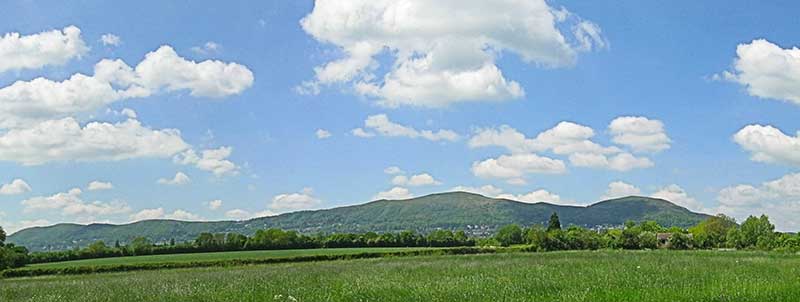
The Victorian 'water cure' doctors of Great Malvern
Much has been written about the springs of the Malvern
Hills and the 'water cure' establishments set up in Victorian times. These
were the days of the Industrial Revolution, when smoke, fumes, poor hygiene
and poor diet were not conducive to good health and many of the medicines
prescribed by doctors at that time were potentially toxic and of
questionable value.
In the 1840s, a group of doctors thought the 'water
cure', by means of fresh air, relaxation, a sensible diet, exercise and
abstention from alcohol, would benefit many of those suffering from stress
and malaise, and during the reign of Queen Victoria, it became very
fashionable for the wealthy to partake of such 'cures'. These treatments
were labelled Hydropathy, later also being referred to as
either Hydrotherapy or the 'water cure'
Many 'water cure' establishments were set up in England,
Scotland and on the continent, largely based upon the principles developed
at Graefenburg in Austria by Vincent Priessnitz; evidence of this can be
found, for example, in advertisements, letters, and reports printed in The
Times newspaper.
Most of the British doctors were qualified physicians but
the conventional medical establishment viewed them with great suspicion.
Occasionally, following a death, a hydropathic doctor would be prosecuted
for seemingly applying the wrong treatment.
Many of the doctors published books about hydropathy and
some believed hydropathy significantly more effective in treating Cholera
than conventional methods.
This page, based upon the secondary sources listed below,
outlines the principal water cure doctors who practised in Great Malvern
between 1842 and 1905, their impact upon the town, where they lived, their
families, and what became of them. In particular we include the story of
Thomas Rayner MD who took over Malvern's largest water cure establishment
following the death of its founder Dr James Wilson in 1867.
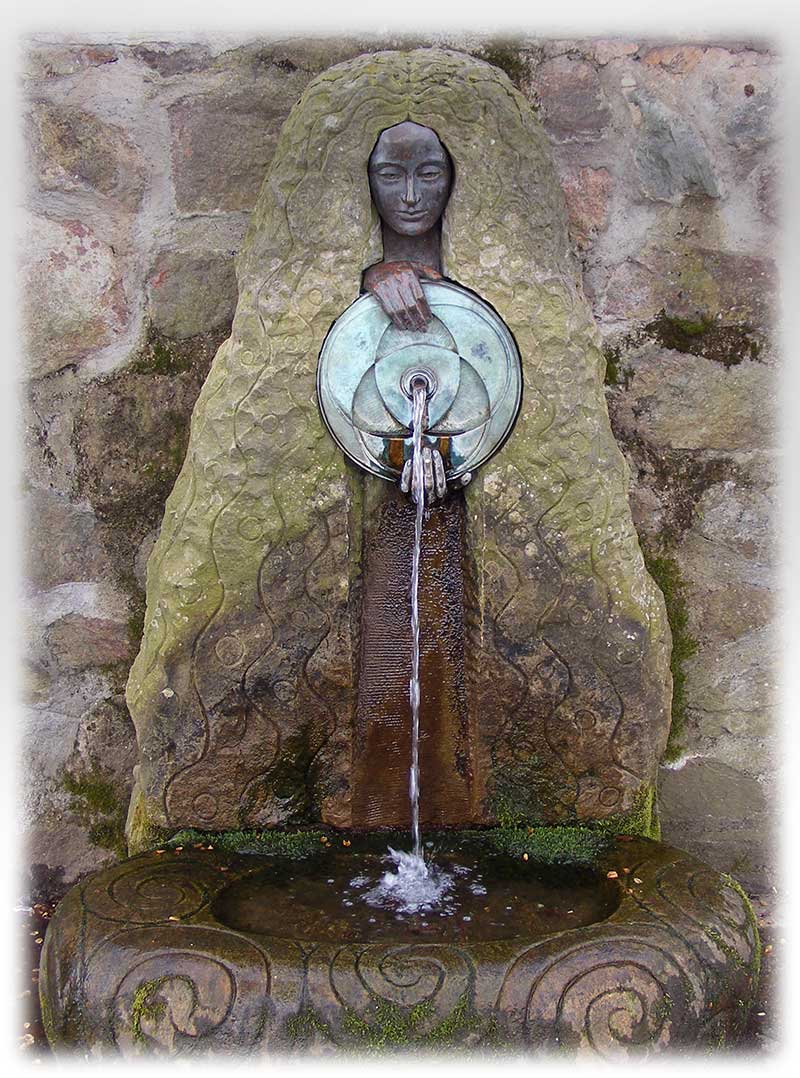 Contents Contents
Dr James Wilson
Dr James Manby Gully
Dr W T Fernie
Dr Ralph Barnes Grindrod
Dr James Loftus Marsden
Dr Leopold Stummes
Dr Edward Johnson
Dr Walter Johnson
Dr Thomas Rayner
Dr John Campbell Fergusson
Photo above: the modern Malvinha drinking spout on Belle Vue Terrace
designed by
Rose Garrard
Dr James Wilson
James Wilson MD, was one of the most prominent water
doctors in England. He was born in the parish of Holywell, Flintshire, in
1807 of an Irish father and Welsh mother. His family were well off and may
possibly have been involved with the coal mining or smelting industries. His
parents died when he was 15, and he trained as a doctor in Liverpool, Dublin
and London. He then gained experience in France and Austria (ref 1).
About 1840 in Nice, France, he married Clara Kortright.
She was the daughter of Cornelius Hendrickson Kortright (1764-1818)
and Juliana Margaretta Waltersdorff (1769-1819).
After several years living in the West Indies the Kortrights moved to
England and bought
Hylands House, near Chelmsford in Essex, their home from 1797 to 1814.
Clara's nephew
Sir Cornelius Kortright became a Governor of British Guiana.
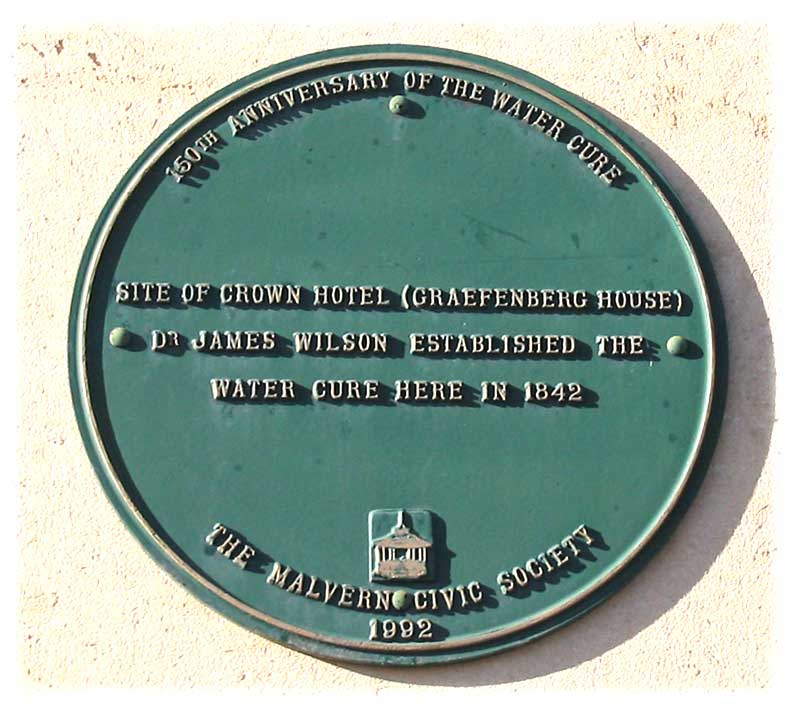 In
1842 Dr James Wilson, with a colleague, James Manby Gully, travelled to
Great Malvern to explore the possibility of setting up a hydrotherapy
practice. They liked what they saw and were able to take a 21 year lease on
the Crown Hotel on Belle Vue Terrace, which was owned or managed by
John Archer, who owned the Foley Arms Hotel and later the Abbey Hotel. A
plaque on Lloyds Bank, which now occupies the site, commemorates this event. In
1842 Dr James Wilson, with a colleague, James Manby Gully, travelled to
Great Malvern to explore the possibility of setting up a hydrotherapy
practice. They liked what they saw and were able to take a 21 year lease on
the Crown Hotel on Belle Vue Terrace, which was owned or managed by
John Archer, who owned the Foley Arms Hotel and later the Abbey Hotel. A
plaque on Lloyds Bank, which now occupies the site, commemorates this event.
As their business grew, attracting the rich and famous, the doctors
decided to dissolve their partnership and set up separate practices in
larger premises (ref 2).
Dr James Wilson acquired land from the
Mason Estate and had built a
magnificent Hydrotherapy Establishment which was completed about 1848 (ref
3); this was often referred to as 'The Establishment'; see photo below. Next
door, to the south, he later had built a large redbrick hotel, known as
Malvern House, and below the Hydrotherapy Establishment, to the east, he had
built a home for his wife and children named Grattan House in Orchard Road -
in the 20th century Dr Wilson's home was demolished to create the Bowling
Green at the south end of Priory Park.
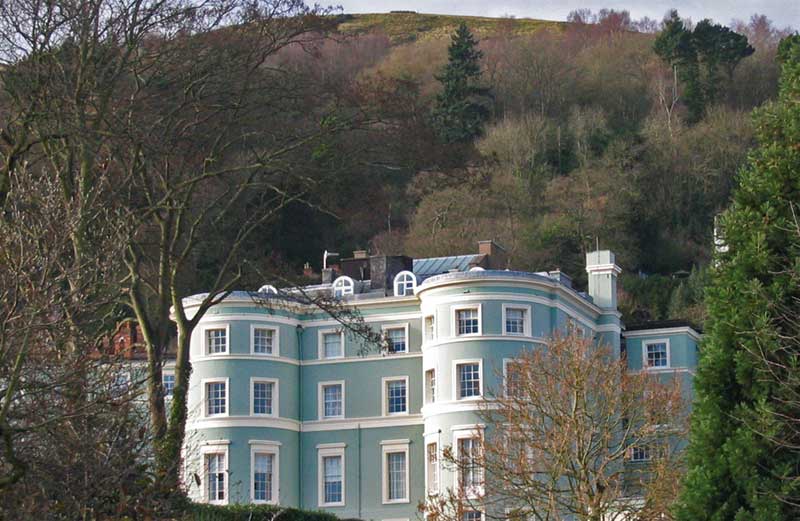
The Establishment, now Park View
Death of Dr Wilson
Sadly Dr James Wilson died unexpectedly on 8th January
1867 while visiting a hydropathic establishment in Yorkshire.
A short report of his death appeared in the Malvern
Advertiser on 12th January 1867:
We regret this week to record the unexpected and sudden
death of Dr Wilson, which took place on Tuesday last at Ilkley Wells
Hydropathic Establishment, Yorkshire. The telegraphic communication of the
event arrived in Malvern the afternoon of the same day. Mrs Wilson for whom
there will be universal feeling of sympathy was in Essex, where she had been
detained by the illness of her brother, who died on the last day of the old
year. The Doctor was on a visit to Ilkley Wells with a view to rest and
change.
Dr Wilson who had made himself familiar with the
water-cure at Graefenberg, where he had derived great personal benefits,
opened an establishment at Graefenberg House, Malvern, about 25 years ago,
when shortly afterwards he united in partnership with Dr Gully.
After a brief connection, this partnership was
dissolved, and a few years subsequently he erected the palatial
establishment in which he resided up to the present period.
Dr Wilson largely gained the confidence of his patients
and commanded an extensive practice, realizing by his professional exertions
a considerable property.
His works on the Water Cure have been extensively
circulated at home and abroad. The funeral, which will take place on Tuesday
or Wednesday next, will be strictly a private one.
Janet Grierson relates that Dr Wilson's funeral was held
on 16th January and that a full account appeared in the Malvern News on
19th. It was well attended.
The Malvern Advertiser of 19th January 1867 seems only to
have contained a rather lengthy and verbose tribute from Dr Wilson's old
friend, and business partner Dr Gully. Here is a transcription:
Dr Wilson
To the Editor of the Malvern Advertiser
Sir. The sudden removal by
death of any member of a small community or brotherhood is always a
circumstance of solemn import to those who remain behind, and one more than
usual calculated to intensify in them individually those reflections on the
great mystery of life and death, which are perhaps, never wholly absent from
even the least heedful of mankind.
In this sense the recent loss of our colleague, Dr
Wilson, while still in the prime of life, and apparently in the enjoyment of
a fair measure of health, must come home to one and all of the small
confraternity of hydropathic practitioners with more than ordinary emphasis;
but it is from another and more important point of view than any personal
one, and with quite different object, that I venture to address you today.
To his infinite credit be it spoken, Dr Wilson was the
first physician in England who gave hydropathy, as a distinct and reformed
system of practical therapeutics, a 'local habitation and a name' in his
native land.
He did so of course amid the usual storm of ridicule
and of interested malevolence that are the natural heritage of all
reformers; and, though he had the happiness to live long enough to see a
large measure of triumph accorded to his own opinions, partly through
the ability of his own writings, and those of others working in the same
field with him; partly also, as always happens, through the gradual
prevalence of truth as a never-failing law, yet in estimating Dr
Wilson's services to medicine, his name must imperishably be associated
with it; and the reflection borne in mind that, but for his initiative,
its introduction into England might at any rate have been delayed for
several years.
Such a service it is almost impossible to estimate aright
in all its bearings at once, on the cause of science and the public welfare.
The time has assuredly not yet arrived when any semblance of justice is
likely to be rendered to the influence of the introduction of hydropathy on
the medical art, but even the most superficial observer must have remarked
how strongly the practice of the day has been modified by it, and what
is perhaps even of greater importance, how largely it has operated for good
on the habits of the modern Englishman in teaching those of lesser
temperance, self-denial, and activity, which go to harden the fibre of the
individual first, and then to raise the general physical stamina of a whole
race.
And if the Englishman's now almost typical 'cold tub' is
allowed to have produced any of these results, candour will place this in a
large degree to the credit of hydropathy, which unquestionably gave the
first impetus to this grand manly habit. To have contributed, even less
directly, to such results as these, might well have satisfied the ambition
of most men, and no one had a better title than Dr Wilson to feel that he
had left his mark distinctively on his age.
He was well entitled to say with Horace 'exegi
monumentum aere perennius;' and it is certain that hydropathy,
established unshakably in our England, is itself by far his
proudest and most enduring monument.
But it seems to me, nevertheless, that this does not
absolve us from the grateful duty of marking by some outward tribute of
respect our sense of the eminent services rendered by the deceased. What
form that tribute should precisely take, I leave for further
consideration; but anything in the form of a public monument, however
simple in construction, which should be erected to his memory in that
beautiful Malvern where Wilson first established hydropathy, and then
with the help of other, as sincere and able as himself, made it a
practical success, would it seems to me, be peculiarly appropriate, and
I am confident that a subscription opened for this purpose would be
gladly seconded not only by his fellow practitioners, but by numberless
persons who, having been restored from sickness to health through the
agency of hydropathy, must needs regard him who introduced it into
England as a public benefactor.
I am, sir, your obedient servant.
A HYDROPATHIC PRACTICIONER
January 17th 1867
Dr Gully's 'anonymous' tribute suggests that decades
after its introduction there was still considerable opposition to hydropathy
from the medical establishment. The following week a letter appeared in the
Malvern Advertiser recommending that any memorial to Dr Wilson should
incorporate a drinking fountain. Here is a transcription:
Malvern Advertiser 27th January 1867
CORRESPONDENCE
MEMORIAL TO DR WILSON
To the Editor of the Malvern Advertiser
Sir - The letter of 'A Hydropathic Practitioner' which
appeared in your last issue will, I am sure, meet with public approval; and
the suggestion which it contains will be practically carried out through the
contribution of many a grateful convalescent. My own acquaintance with Dr
Wilson is of comparatively recent date; but I cannot shut my eyes to what he
has effected by force of character and earnestness of conviction.
In addition to the graceful tribute borne by Dr Gully to
his memory, the extraordinary progress of this town is a powerful witness to
the success of his efforts. It may indeed be said of him as of Sir
Christopher Wren (architect of St Paul's Cathedral) Si monumentum
quaeras circumspice.
Were it possible to consult the wishes of the deceased
himself with respect to the nature of the proposed monument, I am sure that
he would desire it to be of some practical utility; and hereby propose, what
I believe has already been orally suggested, viz, that a well appointed
drinking fountain (now so much wanted) should form a part of the monument
erected to his memory. - I am sir, your obedient servant
ANOTHER HYDROPATHIC PRACTITIONER
Malvern, 24th January, 1867
Click to read about Dr
Wilson's memorial
Burial
Dr Wilson was buried in
Great
Malvern Cemetery which had opened in 1861; he was aged only 59 years.
Click to jump to monument
The practice was taken over by his son, and Dr
Thomas Rayner (see more about below) who took a lease on the Hydropathic
Establishment; nowadays it is a block of apartments known as Park View.
Dr Wilson's wife, Clara, died at 45 Harewood Square,
London on 3rd May 1888 while staying with her daughter. The register of
Great Malvern cemetery records she was buried with her husband on 7th May
1888 aged 83 years.
Children
James and Clara had two children, Henry Grattan Wilson
(1842-1881) and Clara Constance Wilson (1845-1896); both relatively short
lived.
Henry Grattan Wilson like his father became a Physician
and MRCS. After his father's death he went into partnership with Thomas
Rayner MD, but the partnership was dissolved a year later on 29th September
1868, leaving Thomas to run the 'Establishment' (ref 4).
Henry did not marry and died aged only 39 years in
Tunbridge Wells, Kent; he was not practising and we wondered if he was a
victim of tuberculosis.
Clara Constance Wilson was born in Malvern about 1845. In
1876 she married Aubrey Beauclerk Lennox St John, born 1846,
Melbourne, Australia, the son of Major George Frederick Berkeley St John and
Henrietta Louisa Maria Jephson, daughter of Revd Jephson. Clara may have met
Aubrey at a ball at the Imperial Hotel built 1861 where he was secretary and
later chairman of the Malvern Hotel Company.
Aubrey was the grandson of
General Frederick St John who was briefly MP for Oxford.
Aubrey and Clara had one son, James Frederick St John,
born at Monmouth in 1881. In 1909 James married his cousin Henrietta St
John, daughter of civil engineer Henry Augustus Bolingbroke and Anna
Henderson. It is thought Anna was the daughter of a major in the Indian
army.
Clara Constance Wilson died at 15 Kensington-Crescent,
London in 1896, and her husband Aubrey in Ontario, Canada in 1917.
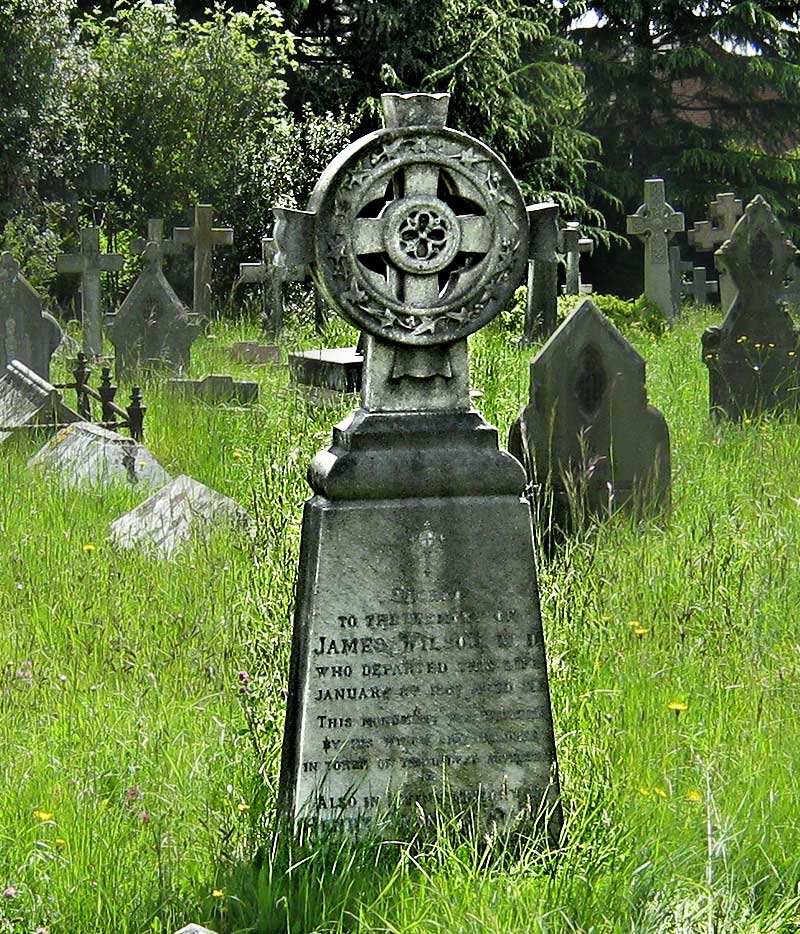 There
is a small monument in Malvern cemetery to the SE of the chapel. It is
partially obscured by larger memorials closer to the path, but helpfully we
found a small notice on the edge of the path which read:- There
is a small monument in Malvern cemetery to the SE of the chapel. It is
partially obscured by larger memorials closer to the path, but helpfully we
found a small notice on the edge of the path which read:-
'Doctor James Wilson. It could be argued that but for the
arrival of James Wilson in 1842 Malvern might have remained but a village.
Having studied the ideas of an Austrian doctor, who extolled the benefits of
water in the treatment of all kinds of illness and disease, and knowing of
Doctor John Wall's pronouncement of the purity of water from the Malvern
Springs, he came to Malvern and set up a hydrotherapy clinic. This proved to
be a great success, and led to the transformation of the village into a
popular and fashionable Spa town.'
The inscription on the monument reads,
Sacred to the memory of James Wilson MD who
departed this life January 8th 1867 aged 59.
This inscription was erected by his widow and children
in token of their deep affection.
Also in loving memory of Henry Grattan Wilson only son
of the above who died May 6th 1881 aged 39.
Also in memory of Clara wife of the above B 1804 D
1888
Legacy
Dr James Wilson led the development of Hydropathy in
Great Malvern in the 1840s, which resulted in the expansion of Malvern as a
health resort, the building of numerous lodging houses and villas, creating
business for architects, builders, tradesmen, hoteliers and shopkeepers
alike.
Park View and Malvern House in Abbey Road, now
apartments, remain standing as monuments to his hydropathic business.
Dr Wilson's home, Grattan House in Orchard Road, stood
on the site of the Bowling Green which lies immediately below Park View on
the south side of Priory Park.
By the 1960s the 'water cure' had been largely forgotten,
but it has been raised to consciousness again by Malvern Civic Society and
authors such as Janet Grierson, Cora Weaver and Dr Harcup.
A memorial fountain to James Wilson had been erected in
Abbey Road in 1877. Arrangements for its maintenance and the water supply to
the drinking fountain were never firmly set in place and in consequence it
sadly fell into disrepair and was demolished in 1948.
In 2015 a new memorial was erected at the junction of
Abbey Road with Priory Road, by Malvern Civic Society, ready to mark the
150th anniversary of Dr Wilson's death in 2017.
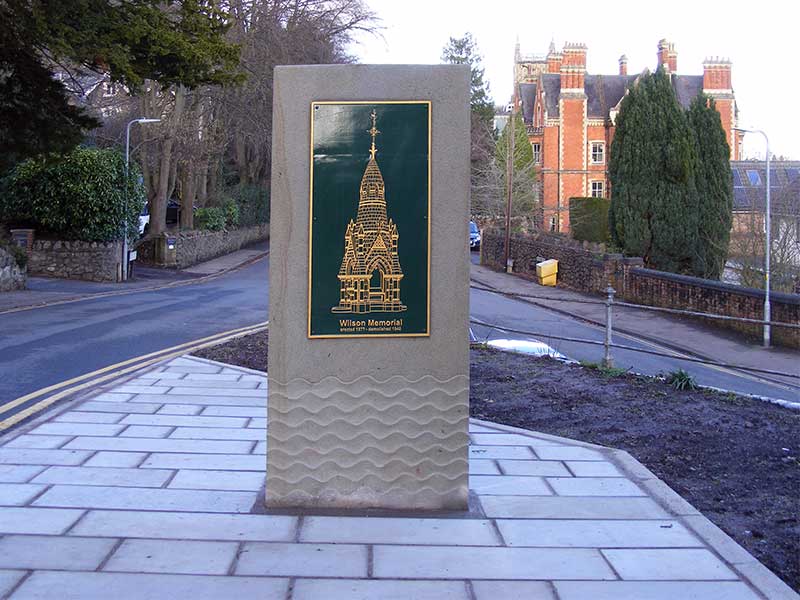
The Wilson Memorial
Malvern House, which was built for James Wilson to
accommodate water cure patients, can be seen in the background.
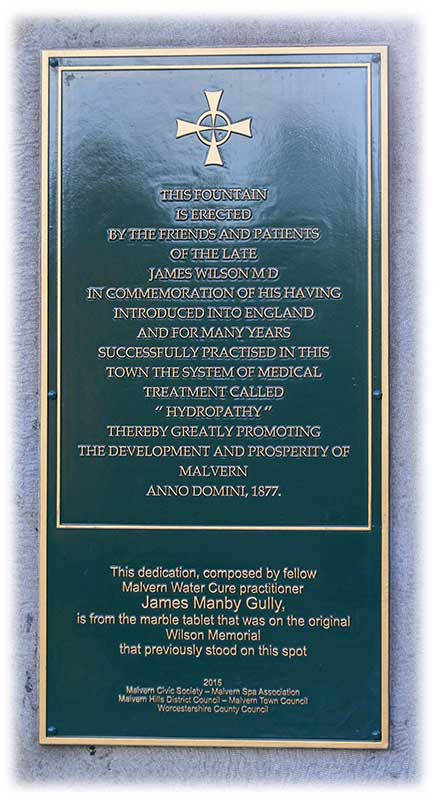 The
plaque on the north side of the memorial reads: The
plaque on the north side of the memorial reads:
This fountain is erected by the friends and patients of the late James
Wilson MD, in commemoration of his having introduced into England and for
many years successfully practised in this town the system of medical
treatment called 'Hydrotherapy' thereby greatly promoting the development
and prosperity of Malvern Anno Domini 1877.
This dedication, composed by fellow Malvern Water Cure practitioner James
Manby Gully is from the marble tablet that was on the original Wilson
Memorial that previously stood on this spot.
2015
Malvern Civic Society - Malvern Spa Association - Malvern Town Council -
Worcestershire County Council.
Dr James Manby Gully
Dr James Manby Gully came to Great Malvern as the
business partner of Dr James Wilson. When they decided to dissolve their
partnership he set up his own hydrotherapy practice at Holyrood House, and
the Haywell Baths next door, on the Worcester Road; opposite the south end
of Rosebank Gardens. To accommodate his expanding business he had the Tudor
House built next door (originally named Newby House). The photo below shows
Tudor House after building work had been completed to convert the
accommodation from a fire damaged hotel to modern apartments. Note the fine
chimneys and viewing towers at the rear.
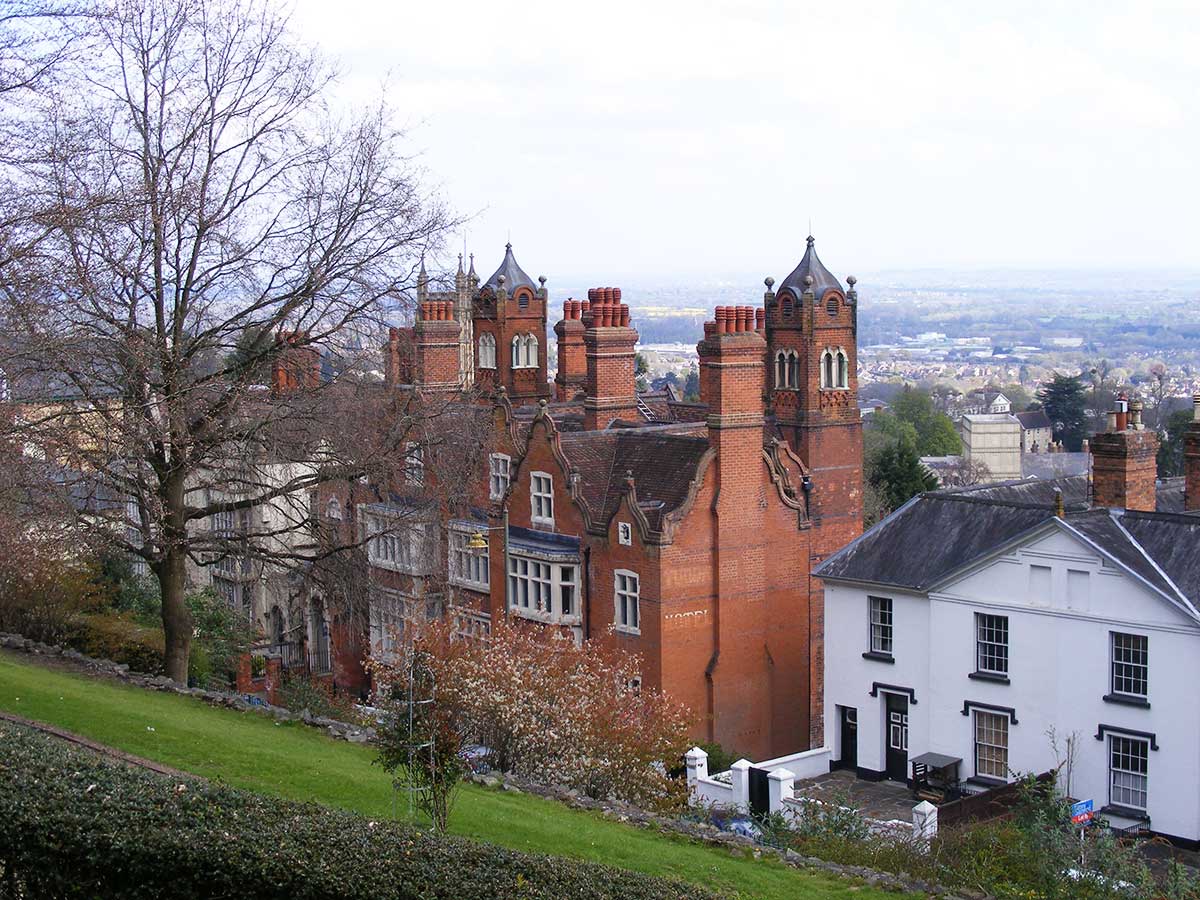
Tudor House in 2019 viewed from Rosebank Gardens
Largely concealed behind the tree on the left of the
photo is Holyrood House.
About 1846 James Manby Gully had published 'The Water
Cure in Chronic Disease'. An advertisement for the book appeared in The
Times on Thursday Feb 24th 1848.
On Saturday April 18th 1857 an advertisement appeared in
The Times linking Dr Gully to a small hydropathic business at Malvern Wells:
Malvern Wells - The Old Well House will be opened as a
Hydropathic establishment for the reception of patients the beginning of May
1857.
Resident physician Dr Ayerst to who all applications for
terms and conditions are to be made.
Consulting physician Dr Gully
Malvern Wells, April 1857
Dr James Smith Ayerst retired from his practice at Wells
House about 1868, and the property then became a boys' school. He died at
Torquay in 1884.
In 1864 Dr Fernie joined Dr Gully and took over the
practice at Tudor House when Dr Gully retired in 1871. Both men were
prominent in town affairs.
Dr James Manby Gully, born in Jamaica in 1808, was the
son of plantation owner Daniel Gully who died in 1823. A copy of Daniel's
Will is held by The National Archives.
His first wife, Frances Court, by whom he had three
children, tragically died of smallpox in 1838 aged only 23 years, and he
came to Malvern in 1842 accompanied by two sisters Ann and Ellen. They made
their home at a house named The Priory, in Priory Park which, after Dr Gully
left Malvern, was demolished to make way for
Priory Park Mansion, now
occupied by Malvern Hills District Council.
Dr Gully was said to have been very personable,
attracting rich and famous clients. He had married second in 1840, Frances
Kibble, from whom he separated soon after their marriage.
Mistress
Approaching retirement, Dr Gully is said to have been
attracted to a young married patient named Florence Ricardo nee Campbell,
with whom, after her husband's death, he was later to have an affair (ref
5). Florence was the wife of Augustus Louis Ricardo, late Captain Grenadier
Guards, who had become an alcoholic and died in Cologne in 1871. In 1861
Ricardo had played cricket for Hampshire against the MCC and was the son of
MP
John Lewis Ricardo (1812-1862). John Lewis Ricardo seems to have been an
important and influential businessman and it is sad that his only son
Alexander came to an unfortunate end.
John Lewis Ricardo formed a consortium which
established the Electric Telegraph Company in 1846. Initially lines were run
besides railway tracks; it was not until the late 1870s that the
telegraph reached Malvern.
Read more about the telegraph on our page about Public
Utilities.
Florence, born Sydney Australia in 1845, was the daughter
of Robert Campbell, who in 1881 was recorded as a gentleman farmer of 1,500
acres living at Buscot Park House.
Humiliation
After her affair with Dr Gully, Florence married second
in 1875, Barrister, Charles Delaney Turner Bravo, who died of poisoning only
a few months after their marriage in 1876. Dr Gully was called to give
evidence at the inquest, which exposed his past affair and sadly this
brought him humiliation and deletion of his name from the medical register.
Florence herself died soon after in 1878 aged only 33 years; probably from
alcoholism.
Death
Dr Gully who had retired from Malvern to London in 1871
to live near his mistress, Florence, died at Orwell Lodge, Balham in 1883
aged 75 years. Perhaps he named this house after Orwell Lodge in Great
Malvern where Florence, had resided (ref 5).
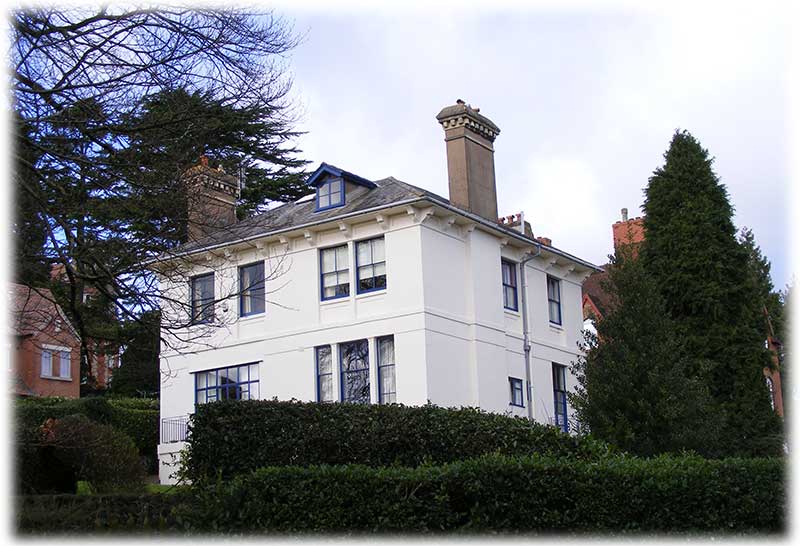
Orwell Lodge, Woodshears Road, Malvern
So it was that Dr James Manby Gully came to be buried in
the famous
Kensal Green Cemetery far away from Great Malvern where he had gained
fame as an exponent of the Victorian Water Cure.
See photo below showing the location of his grave and
under that a close up of the headstone, courtesy of Colin Fenn (ref 23) who
is vice chair of the
National
Federation of Cemetery Friends. Click photos to enlarge and view
inscription.

The inscription on the headstone reads:
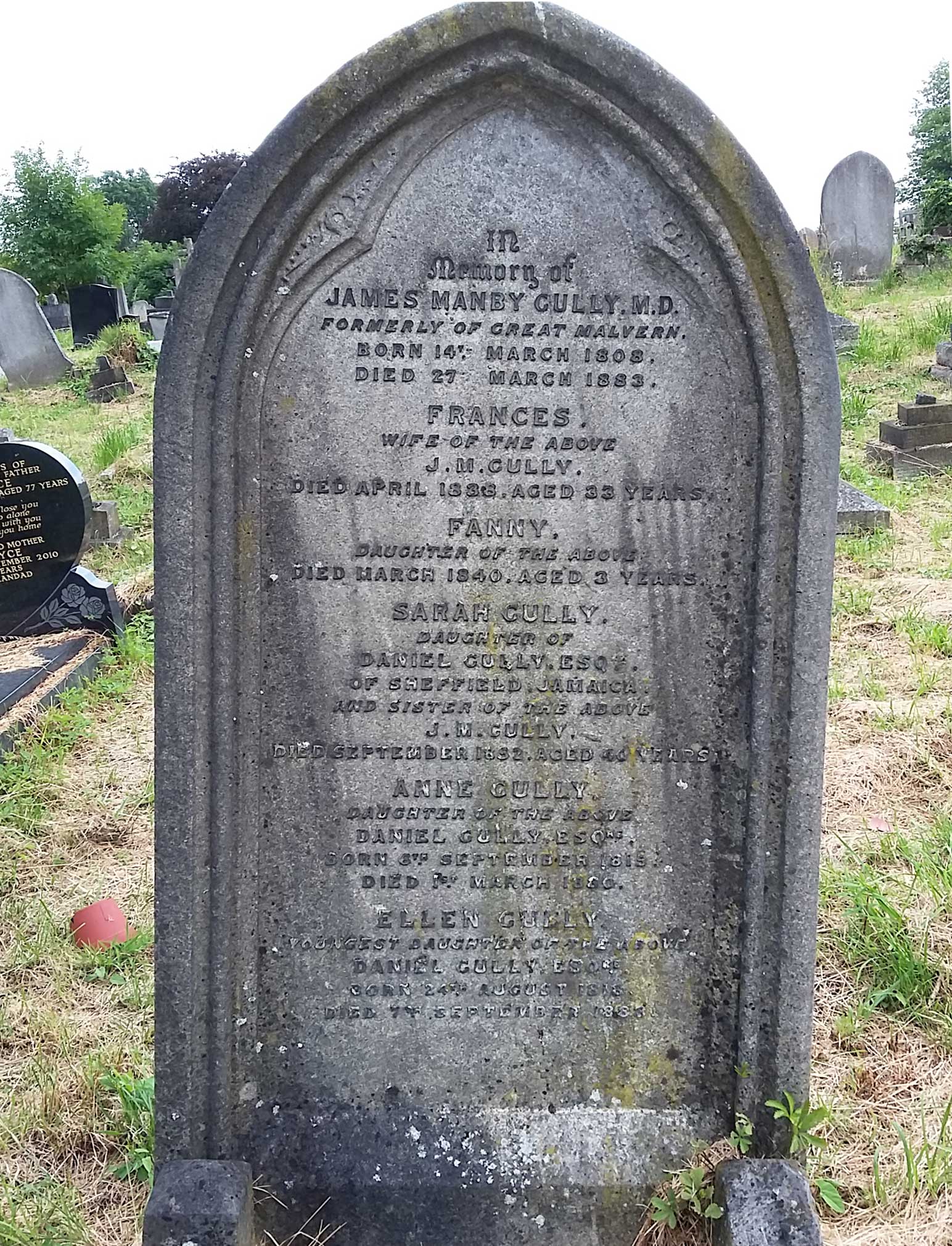 In
Memory of James Manby Gully MD, formerly of Great Malvern. In
Memory of James Manby Gully MD, formerly of Great Malvern.
Born 14th March 1808
Died 27 March 1883
Frances wife of the above JM Gully
Died Apr 1838 aged 33 years.
Fanny daughter of the above Died March 1840 aged 3 years
Sarah Gully daughter of Daniel Gully Esq of Sheffield, Jamaica. and
sister of the above JM Gully Died September 1852 aged 40 years.
Anne Gully daughter of the above Daniel Gully Esq
Born 6th September 1815 Died 1st March 1880.
Ellen Gully youngest daughter of the above Daniel Gully Esq
Born 24 Aug 1818 Died 7 Sep 1888
The inscription was possibly devised by his youngest son and executor,
William Court Gully QC.
Children
By his first wife Frances Court, Dr Gully had four children,
Charles James Gully (1832-1928)
Susannah (1833-1903)
William Court Gully (1835-1909)
Frances (1837-1840)
Apart from Frances who died an infant all children made
good marriages and had issue.
Little is known about Charles except that he is thought
to have married in New Zealand in 1857 and died in Italy.
In 1856, Susannah married William Henry Jeffcock
(1832-1863). by whom she had 5 children. William Henry Jeffcock, the
grandson of a colliery owner, was the son of William Jeffcock (1800-1871)
and Judith Stobart.
William Jeffcock senior is said to have been the first Lord Mayor of
Sheffield and commissioned the building of
High Hazels House in 1850.
William Court Gully, like his father, made his mark in society. He was
educated at Cambridge, was President of the Union, Barrister at Law, Queens
Counsel, MP for Carlisle 1892 - 1905, and Speaker of the House of Commons
1895 to 1905. Created Viscount Selby in 1905. He married in 1865 Elizabeth
Anne Walford Selby by whom he had 6 children.
Legacy
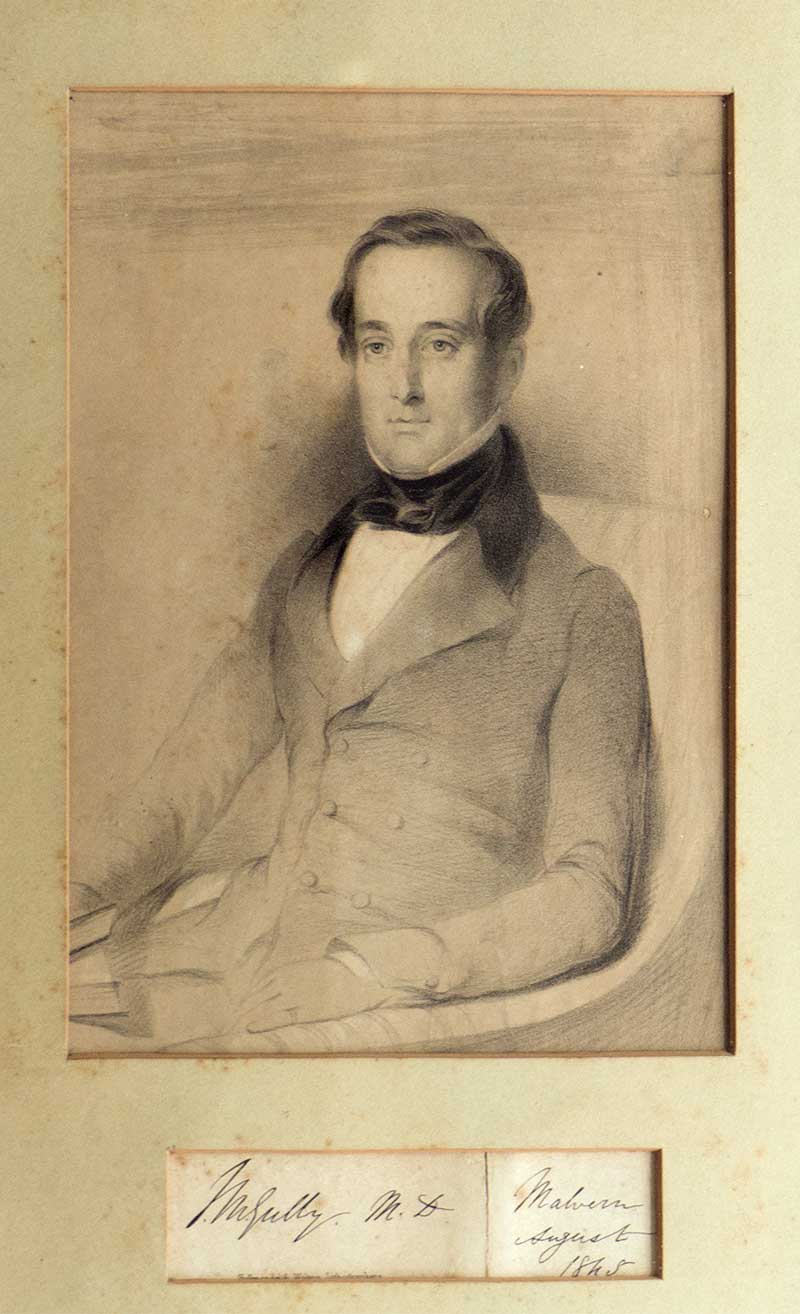 Dr
Gully's main legacy is that, with Dr Wilson, he is credited with the
expansion of the water cure from 1842 through to about 1871. The buildings
named Holyrood and Tudor House where he established his hydrotherapy
practice still exist and have been converted into apartments - the site of
his Bath House is now occupied by the Baptist Church. Dr
Gully's main legacy is that, with Dr Wilson, he is credited with the
expansion of the water cure from 1842 through to about 1871. The buildings
named Holyrood and Tudor House where he established his hydrotherapy
practice still exist and have been converted into apartments - the site of
his Bath House is now occupied by the Baptist Church.
History also records his affair with Florence Ricardo in
the form of newspaper reports of the poisoning of her second husband
Barrister Charles Delaney Turner Bravo in 1876 and the subsequent
investigation.
As described above, his son William Court Gully went on
to become an MP and a Speaker of the House of Commons, in spite of the bad
publicity which arose from his father's affair with Florence Ricardo.
Sketch right: James Manby Gully MD August 1843, source
Malvern Library
Dr W T Fernie
When Dr Gully retired, his assistant Dr William Thomas
Fernie MD (1830-1914) took over the practice at Tudor House. Dr Fernie was
the son of clergyman John Fernie who in 1861 was Rector of Yelden. His elder
brother John became a clergyman and his younger brother Andrew became a
Physician. Possibly Dr Fernie's eventual move from Malvern to London had
something to do with his brother Andrew's premature death in 1884.
Trade directories from 1879 record Elijah Finn as the
proprietor of the Tudor House Hotel and the Haywell Baths; he had previously
been a boarding house keeper at Hardwicke House. Elijah Finn died at the
Tudor House in 1886; whether Dr Fernie had continued to supervise the water
cure patients between 1879 and 1886 we do not know.
Children
Dr W T Fernie had no children of his own by either his
first wife Emma or his second wife Jane Adele Graves who he married at
London in 1891, but he had several nephews and nieces.
In 1901 his nephew (Private) Maxwell Fernie died of fever
in South Africa during the Boer war.
Legacy
Few people remember the name Dr W T Fernie today, but,
according to Dr Harcup's excellent book 'The Malvern Water Cure' (ref 2), he
was Chairman of the Assembly Rooms and Pleasure Gardens Company which built
the glass covered Assembly Rooms, the predecessor of the present theatre
complex.
He was also interested in the use of herbal
remedies and published, for example, 'Herbal Simples' in 1897.
More about Tudor House
By the time Dr Fernie left Great Malvern and Elija Finn
had died, the water cure was probably on the wane as the Tudor House then
became a hotel (ref 6) and, not long after, the Baptist Church was
built on the site of the Haywell Baths.
The Tudor Hotel was next owned, in partnership, by James
Buckingham and the Misses Brown. It is mentioned in his will proved in
1900:-
Whereas I am the owner of one third share of an Hotel and
the business of an Hotel Keeper at Malvern carried on in partnership with
the Misses Brown under the style of Brown and Buckingham I especially
authorise my trustees to concur in winding up the business of Brown and
Buckingham or any other business in which I may be a partner at the time of
my death - will dated 16th December 1896.
The 1891 census shows James Buckingham and his wife Sarah
Elizabeth (Seaman) managing the Tudor Hotel. He was born Long Marston,
Buckinghamshire about 1839, and earlier the 1881 census had described him as
a Dairyman employing six men and two boys, living in Hampstead. He seems to
have died at Hampstead in 1900 where his children may have continued to run
the family Dairy business.
From the 1901 census it appears the next proprietor of
the Tudor Hotel was widow, Harriet Amelia Young, born Gloucester about 1849;
she was still there in 1911 and died at Salisbury House in Abbey Road in
1934. Her husband Henry who died in 1898 had been a hotel keeper in London
and possibly Torquay
Both in 1891, 1901 and 1911, at the time of the census,
there were relatively few visitors compared to the number of servants.
Perhaps visitors mostly came in the summer but one wonders whether the
business made much money.
Dr Ralph Barnes Grindrod
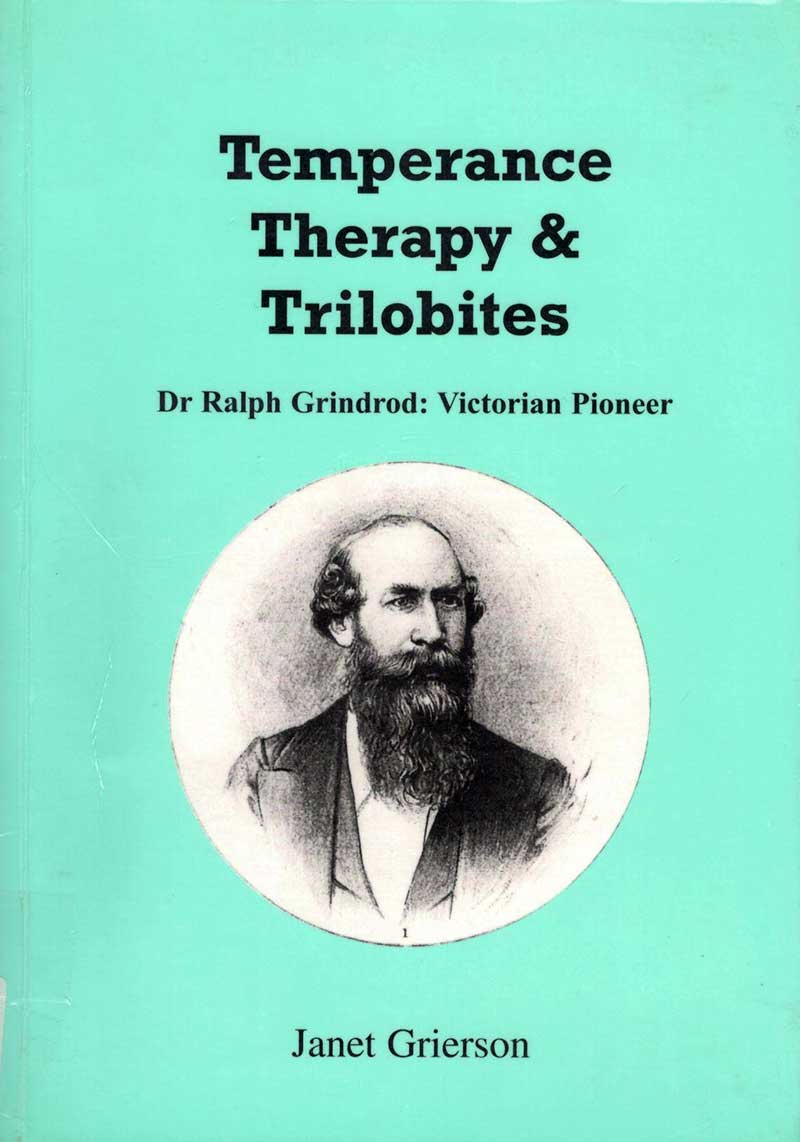 We
have recently come across an excellent and well researched biography of Dr
Grindrod, written by Janet Grierson, which can be found in the Local
Reference section of Malvern library (ref 7), and to which you should refer
for a fuller account. We
have recently come across an excellent and well researched biography of Dr
Grindrod, written by Janet Grierson, which can be found in the Local
Reference section of Malvern library (ref 7), and to which you should refer
for a fuller account.
Dr Ralph Barnes Grindrod (1811-1883) was an orthodox
physician, and vigorous promoter of the Temperance movement, who came to
Malvern about 1850. He was the son of James Grindrod who, in 1851, was a
Manchester publican. His eldest brother Thomas William Grindrod was a
surgeon and his brother James Newton Grindrod was a restaurateur.
On 30th August 1837 at the Collegiate and Parish church
Manchester, the forerunner of Manchester Cathedral, physician Ralph Grindrod
married, Mary Whiteley Hull, the daughter of a Worsted Dealer. They had one
son Charles Frederick Grindrod (1847-1910) who was the author of 'Malvern
What to See and Where to Go'.
In 1850, Ralph Grindrod moved his practice from
Manchester to Townshend House in Great Malvern (see photo below) and we
wondered how the name Townshend House arose. One possibility is that the
name related to the house then being at the 'end of the town'.
(Interestingly there is an Arthur Edward Townshend died
October 23rd 1927 buried in Malvern cemetery, who was of a wealthy Irish
family and probably retired to Malvern after 1913, so not a connection).
Townshend House
Townshend House, possibly built in the 1840s, still
stands next to St Edmund's Hall near the NE corner of College Road. See
photo below, which shows a side view of the house and a glimpse of St
Edmund's Hall beyond.
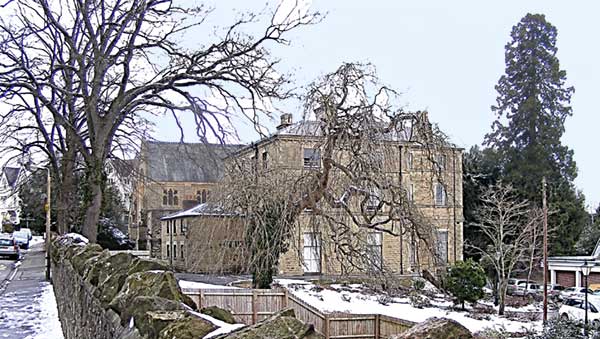
Townshend House
A picture in Malvern library (see image below) suggests
the house used to have a large rear garden where patients and visitors could
promenade. Mrs Grindrod is said to have held a four day bazaar there to help
raise funds for the building of the Lansdowne Methodist Church which opened
in 1866.
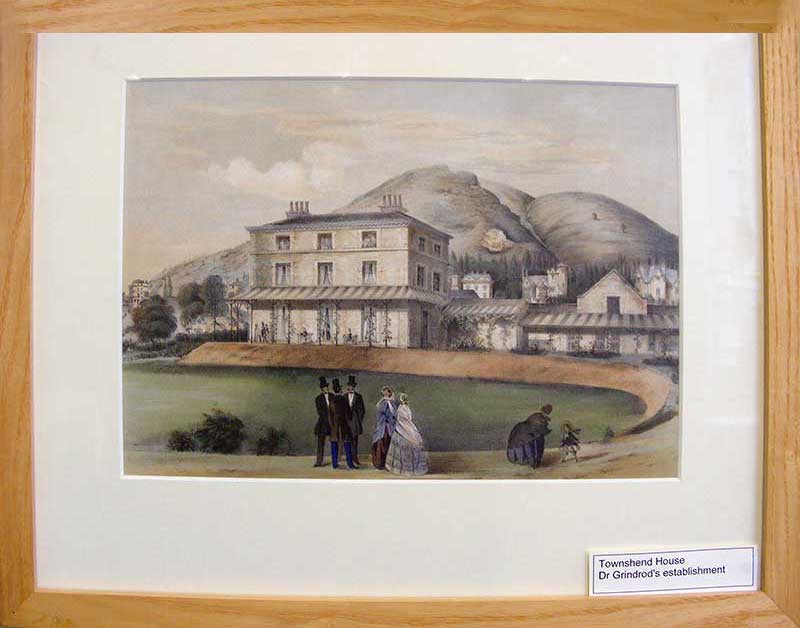
Rear of Townshend House, courtesy of Malvern Library
Dr Grindrod lived at Townshend House, from 1850 to 1880,
where he practised the water cure besides other treatments. Called the
medical apostle of Temperance, Dr Grindrod is said to have
spent a considerable amount on efforts to promote the Temperance movement.
In 1833, he may have been the first medical man in England to sign the total
abstinence pledge. Perhaps he had observed the damage drink could do during
visits to the sick in Manchester.
Dr Grindrod wrote books, promoted the education of the
children of the poor, analysed local water supplies and was a member of the
Town Board.
In 1855 he had founded the Malvern Advertiser newspaper
which he passed on to John Sloggett
Jenkins in 1867 when he began finding it difficult to run the newspaper
in addition to his medical work (ref 7). As a Methodist, John Slogget
Jenkins would have been a teetotaller, like Dr Grindrod.
About 1861 Townshend House was extended by Edward C
Allflatt, Architect and Surveyor, (1832-1890) of Leigh in
Worcestershire, and the 1861 census records Dr Grindrod boarding at Dr
Wilson's Hydropathic Establishment in Abbey Road (now Park View).
Circa 1871, Dr Grindrod introduced a new and unique form
of treatment in Malvern known as the Compressed Air Bath or
Hyperbaric Treatment. In this the patients sat comfortably in a
room where the pressure was gradually increased to about one and a half
atmospheres and then back to normal over an hour or so. It was said to help
chest conditions.
By 1881, Dr Grindrod had retired due to ill health and
Townshend House was rented by widow Mary Bramwell aged 86 born Penrith,
Cumbria, and two of her daughters. In 1861 she had been living at historic
Hardwick Hall in Derbyshire with her husband Christopher Bramwell, a
Wine Merchant and Magistrate. Also living at Townshend House in 1881 was
George Nurse, a 'bill poster'.
The 1881 census recorded Dr Grindrod as a retired medical
practitioner living not far away from Townshend House at
Montpellier House in
Albert Road North, which later became a school, and is now Ivydene, recently
modernised and converted into apartments.
At the time of his death in 1883, Dr Grindrod was lodging
at The Ruby in Malvern Wells near his son. He is buried in
the churchyard of St Peter's, Malvern Wells, on the corner of Green Lane.
The burial ground is still accessible to the public, but the church became
redundant in 1994 and is now divided into apartments
Townshend House was eventually sold about 1886 to
schoolmaster Rev William Walker (1838 - 1915), who opened Connellan
College,
a prep school for boys, there in 1888. The school was probably named after
Rev Walker's wife Bedelia Anna Connellan whose family came from Sligo in
Ireland.
Connellan College prep school was short lived for Rev
Walker moved on in 1890 to become headmaster of Thorp Arch prep school in
Yorkshire.
The remains of the name 'Connellan' can still be seen at
the top of one of the gate pillars (see photo below).
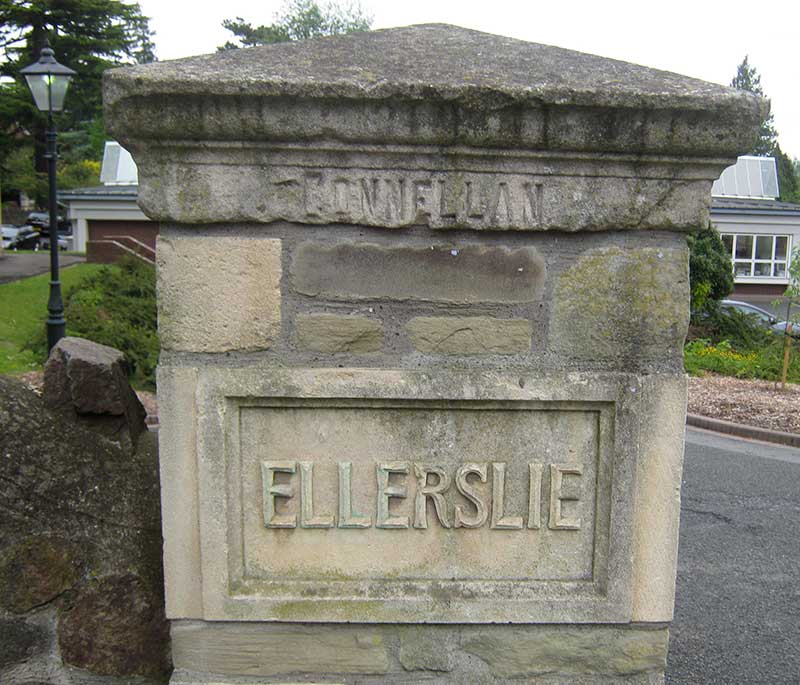
Name 'Connellan' on gate pillar
The census records that Connellan College next became a
small Roman Catholic monastery and, in 1901, that Townshend House had been
renamed Connellan.
The history of the Roman Catholic community in Malvern is
obscure, but it appears the college had been founded for Benedictine monks
who were unwelcome in France. The monastic college had connections with the
management of St
Joseph's church and
school in Newtown
Road, but eventually the college moved from Malvern for financial
reasons, and in 1918 the property was acquired by Malvern College.
The photo of 'Townshend House' below was taken from near
the entrance pillars. On the left hand gate pillar (see photo above) the
inscription 'Ellerslie' has been added, circa 2010; this relates to the move
of Ellerslie Girls' School in Abbey Road to Malvern College.
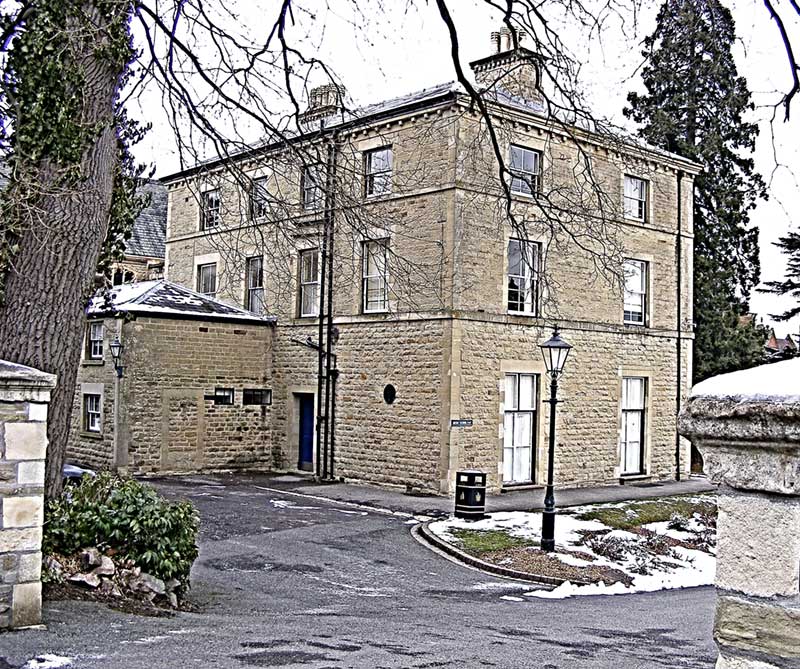
The former Connellan College, previously Townshend House
On the front of 'Townshend House' can be seen a green
plaque, placed by Malvern Civic Society.
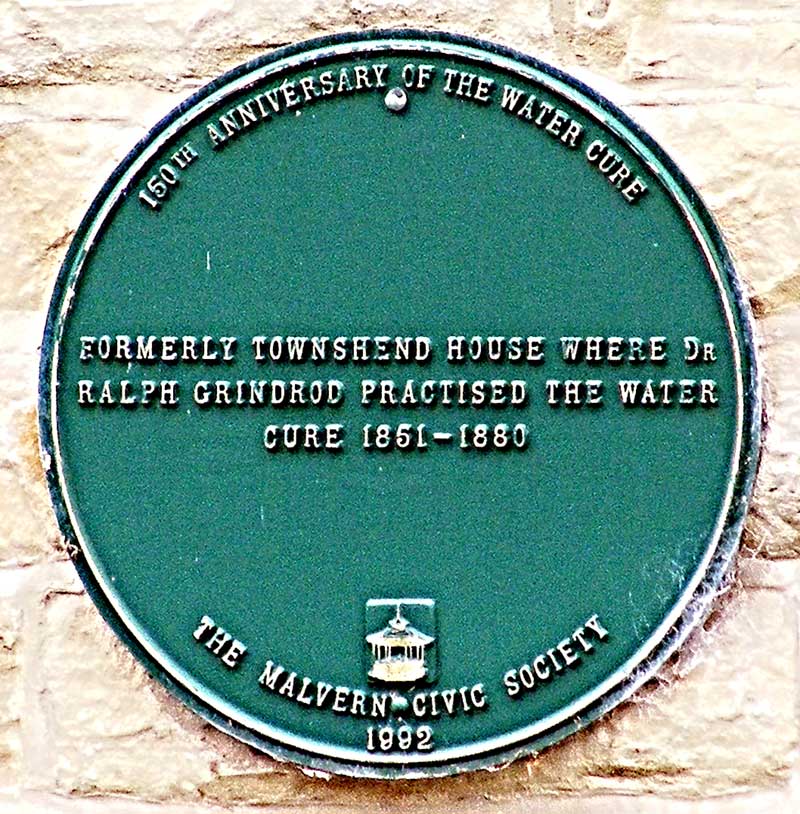 The
inscription on the plaque reads, The
inscription on the plaque reads,
Formerly Townshend House, where Dr Ralph Grindrod practised the Water
Cure (1851-1880)
Legacy
Townshend House is now owned by Malvern College and has
lately been used as a Music School.
Ralph's son Charles Frederick Grindrod became a physician
like his father and lived in Malvern Wells until his death in 1910. At one
time he was a neighbour and friend of Edward Elgar. He was a keen
photographer and took a portrait photograph of Elgar about 1903 which was
gifted to the National Portrait Gallery in 1934 by Elgar's friend,
architect, Arthur Troyte Griffith (who is mentioned in the
Enigma Variations). Charles lived at Wyche-Side on the Wells Road, and
Elgar nearby at Craeglea, now number 86.
Charles, like his father, was a writer and was the author
of 'Malvern What to see and Where to go' (1899). He married Mary Ellen
Higgins, but they had no children.
Click to read our
short biography of Dr Grindrod, which includes his obituary.
Dr James Loftus Marsden
Dr James Loftus Marsden MD (1815-1891), born Dublin, was
the son of Captain James Marsden (1777 - 1841), 7th Dragoon Guards, and
Worcestershire-born Harriett Long (1781 - 1865), the daughter of an attorney
who married at Worcester in 1801.
His parents maintained an attachment to Worcestershire
and their eldest son Frederick Carleton Marsden, who pursued a military
career, was baptised in the district of Upton Upon Severn. According to
Malvern Museum (ref 8) and his will (ref 9), the family owned 'Rose Cottage'
at Barnards Green, Malvern; this was a large house which stood behind the
present bus shelter on the corner of Avenue Road. Rose Cottage was renamed
'The Chestnuts' circa 1920 and demolished in the 1960s in order to built the
block of flat-roofed apartments now known as 'Chestnut Court' (ref 9).
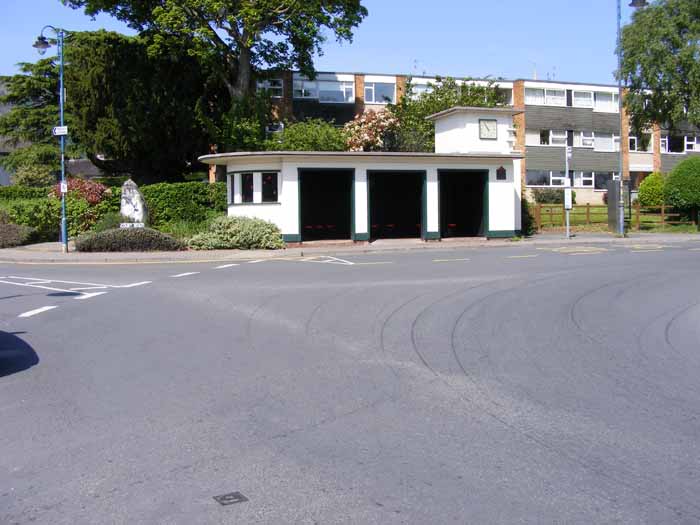
Barnards Green, Chestnut Court and the Bus Shelter
When Captain James Marsden died in 1841 the family was
living at The Palace, Kempsey, and Rose Cottage was rented out. He was
buried at
All Souls Cemetery, Kensal Green on 23rd August 1841; Kensal Green
Cemetery had been established in 1833 under the auspices of the
General Cemetery Company
by act of parliament.
Great Malvern Cemetery did not open until 1861.
Captain Marsden's widow, Harriett, and their surviving
daughter then moved to Cheltenham where Harriett died in 1865.
Earlier, in 1838 at Cheltenham, Dr James Loftus Marsden
had married Lucy Frances Rashdall, the daughter of deceased Lincolnshire
solicitor Robert Rashdall, and about 1846 he moved with his family to
Malvern to work with water-cure Dr James Manby Gully. It was an area he knew
well.
Meanwhile younger brother John Long Marsden born at
Cheltenham about 1820 pursued a military career with the 8th Regiment of
Foot; Ensign 1837; Lieutenant 1839; Captain by purchase 1843. Sadly Captain
John Long Marsden died at Karachi, Bombay, India where he was buried on 16th
October 1848 aged only 27 years.
In 1849 Dr James Loftus Marsden published 'Notes on
Homoeopathy' which was reprinted as a second edition in 1856. He was a
supporter of the Royal London Homeopathic Hospital founded in 1849, and gave
a lecture 'The Action of the Mind on the Body' which can still be found in
booklet form. In those days we imagine mild Homeopathic remedies, although
having no scientific basis, probably killed fewer patients than traditional
medicines!
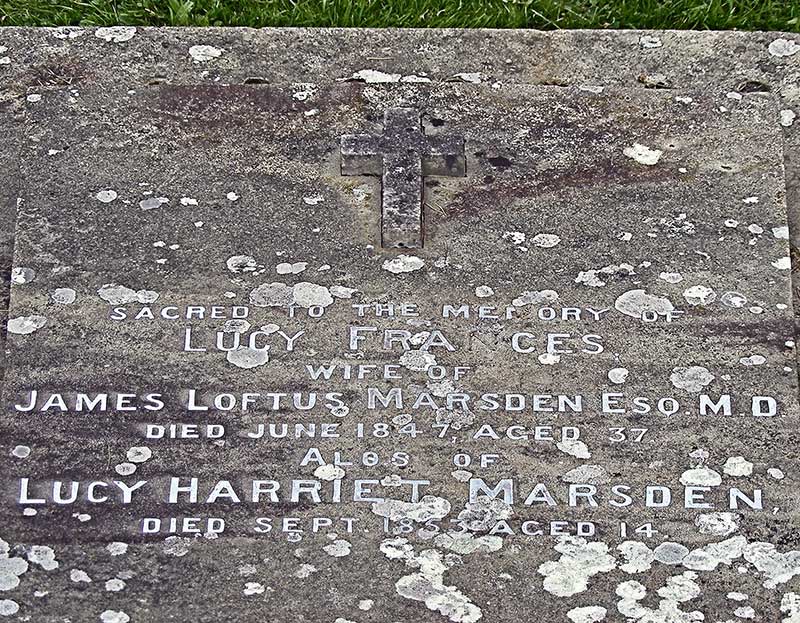 Tragically
his wife Lucy Marsden died in childbirth in 1847 and she was buried in the
churchyard of Great Malvern Priory (see photo of memorial opposite). Tragically
his wife Lucy Marsden died in childbirth in 1847 and she was buried in the
churchyard of Great Malvern Priory (see photo of memorial opposite).
Lucy was the aunt of Oxford theologian
Hastings Rashdall and sister of Revd John Rashdall who was vicar at
Great Malvern Priory between 1850 and 1856.
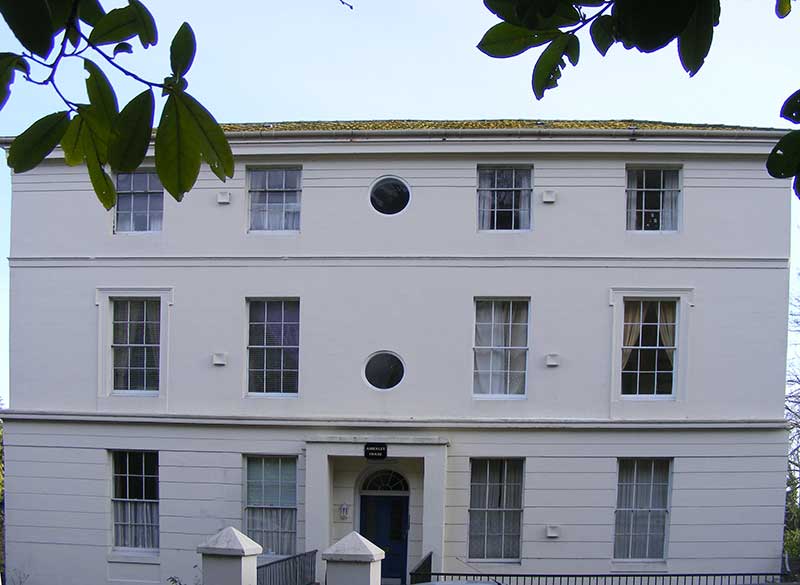 Upon
arrival in Malvern, Dr Marsden had initially rented accommodation at
Abberley House (ref 10). Upon
arrival in Malvern, Dr Marsden had initially rented accommodation at
Abberley House (ref 10).
The house still stands, see photo left, and is numbered
56 Worcester Road.
By about 1850, and following his father's death, James
had acquired land on the east side of Abbey Road on which he built his own
water-cure establishment comprising Hardwicke House (1851), and Elmsdale
(1853) next door, with large gardens, and a purpose built Bath House on the
slope below, on the edge of what is now College Road.
Hardwicke House
The 1871 census recorded Hardwicke House as a boarding
house kept by Elijah Finn and his wife Mary, who either were employed by Dr
Marsden, or leased the property from him.
Earlier, in 1861, Elijah, born Kent about 1827, had
been recorded as a servant at Great Malvern Vicarage. The vicar of Great
Malvern Priory was then the Revd George Fisk who had led the funeral service
of Dr James Wilson of the Hydropathic Establishment on 16th January 1867.
Revd George Fisk is buried on the SE corner of the chapel of Great Malvern
Cemetery not far from James Wilson.
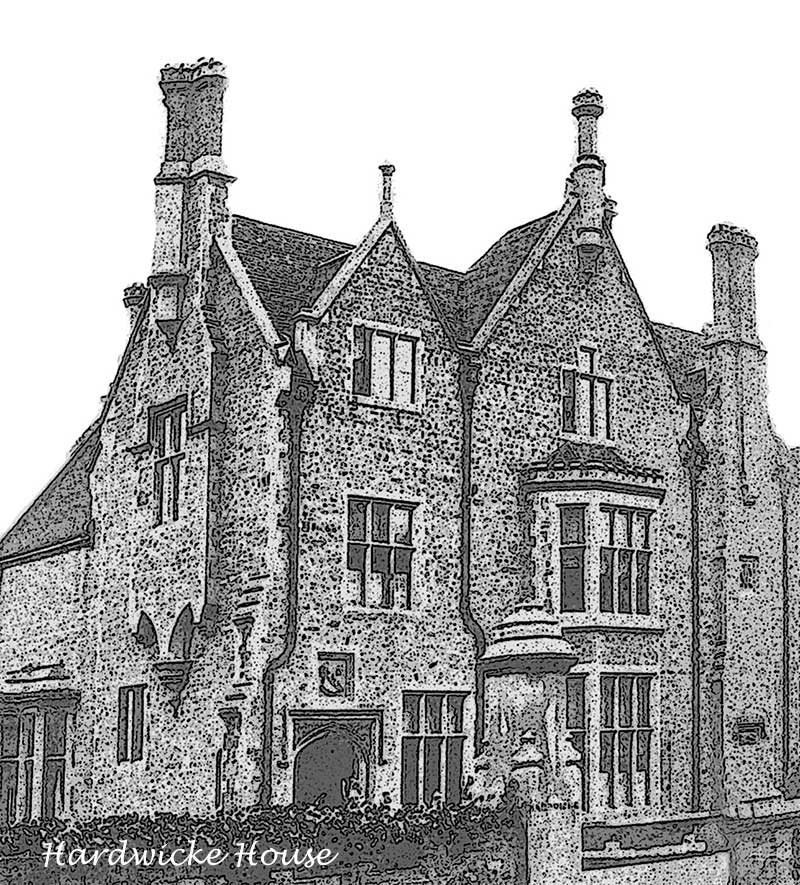 Apart
from photographs and illustrations, there is no trace of the original
Hardwicke House now. Apart
from photographs and illustrations, there is no trace of the original
Hardwicke House now.
In the 1960s, the building (see illustration opposite) eventually fell into
disrepair and was demolished about 1965.
It was replaced by a modern block of flat roofed apartments. These have good
views but are in stark contrast to the original property and the other
Victorian houses in Abbey Road. (We wonder why the planners allowed this.)
The photo below, taken from College Road, shows the east
side of the modern Hardwicke House which overlooks the Severn plain.
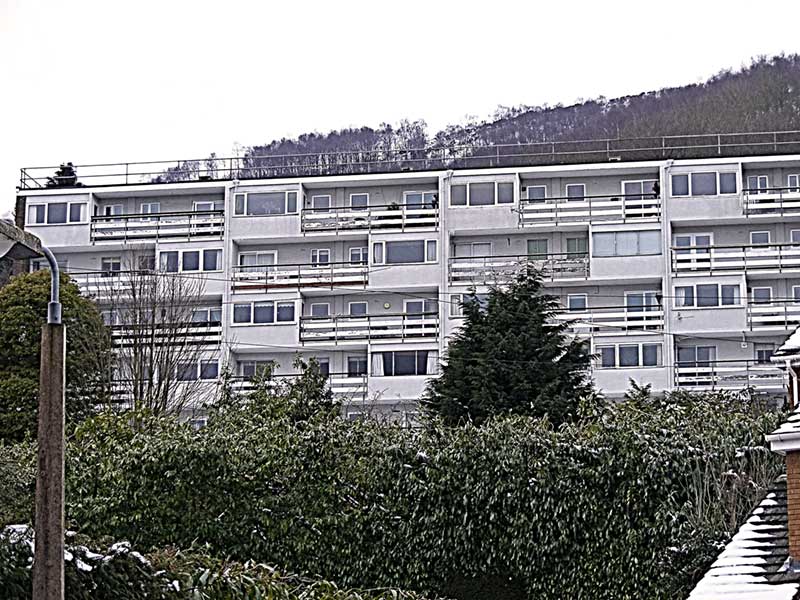
The modern Hardwicke House
North Abbotsfield
The 1861 census recorded Dr Marsden's children living at
North Abbotsfield, on the other side of Abbey Road where Dr Marsden lived
with his second wife Mary, when not touring abroad. This is now number
14 Abbey Road (see photo below).
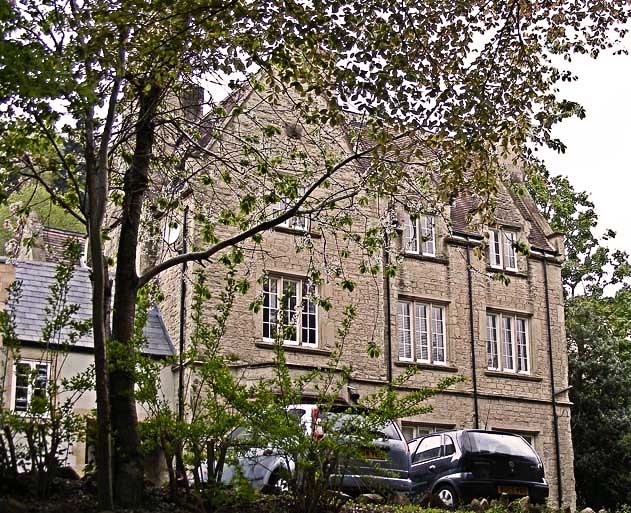
Abbotsfield
Elmsdale
Elmsdale was built next door to Hardwicke House about
1853 possibly to a design by architect
Samuel Sanders Teulon. It has stepped gables with a two storey
balustraded porch, and a north tower sporting a broached spire.
On either side of the
porch
is the letter 'M' and over is a shield with a unicorn. A
feature
on the tower seems to be three swords or some such decoration set into the
stonework.
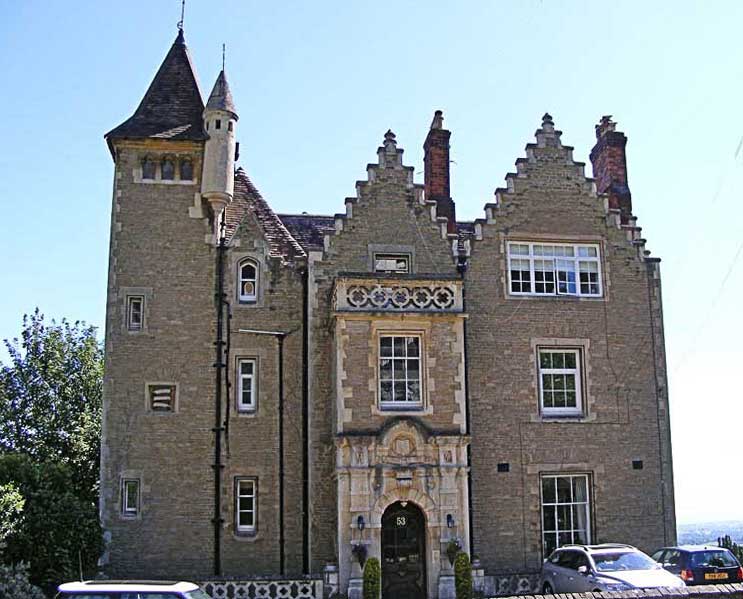
Elmsdale
We wonder how successful Dr Marsden's water cure business
was, as by 1857 Elmsdale was let to
Caroline Cooper who ran a
school for young ladies. The 1871 census and Littlebury's Directory and
Gazetteer of 1873 record that Elmsdale then became 'The Ladies College' run
by Mrs Rachel Rose Gilbert, which was listed in the publication 'Schools for
Girls and Colleges for Women' published by Charles Eyre Pascoe in 1879.
Schools occupied Elmsdale until at least 1908 by when the
'water cure' was on the wane. Click to
go to our page about past Malvern Schools
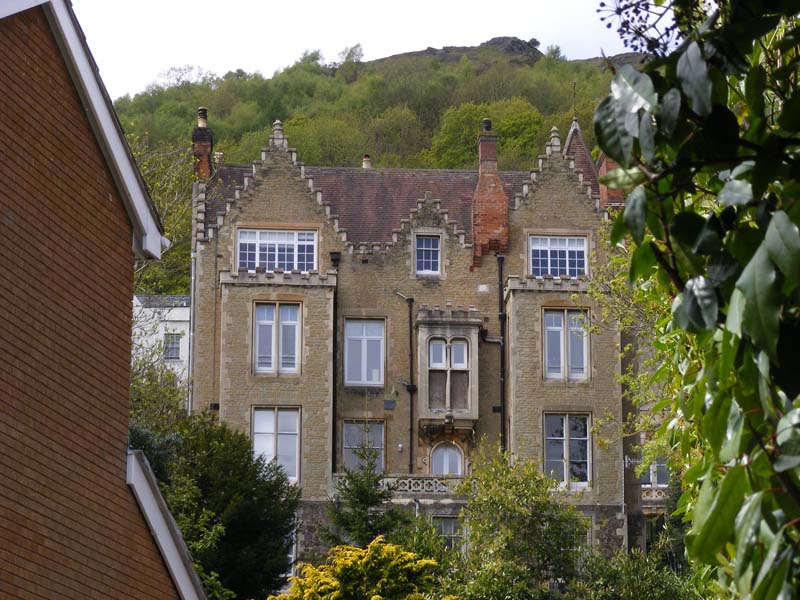
The rear of 'Elmsdale' viewed from College Road
The Bath House
In 1867 James Loftus Marsden became a Freemason, joining
Royds Lodge. After Dr Marsden retired the 'Bath House' became a Masonic
Hall, but is now a private residence aptly named Royds Lodge (see photo
below taken from College Road).
The Masonic Lodge moved to larger premises on Belle Vue
Terrace, where it is today.
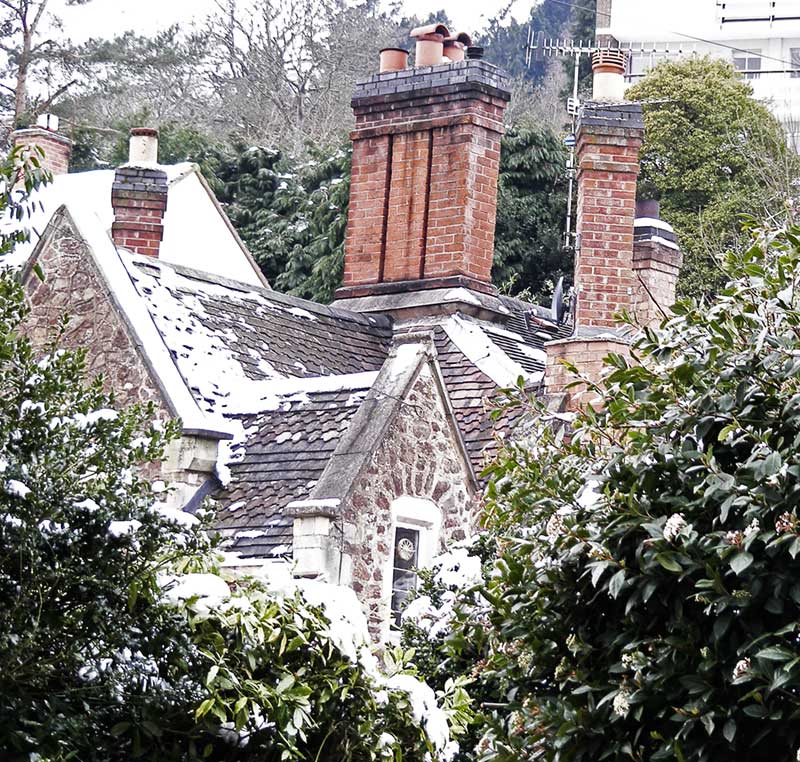
Royd's Lodge glimpsed from College Road
Tenuous connection to Governor Lachlan MacQuarie
Dr Marsden had married second in 1852 at Edinburgh a
Scottish lady named Mary Lyon Campbell by whom he had a daughter Isabella
who died unmarried in 1887 aged only 33 years.
Mary Lyon Campbell was the sister of Isabella Campbell
who had married the son of a famous man named
Lachlan MacQuarie. Major General Lachlan MacQuarie had
been the governor of New South Wales from 1810 to 1821. He was a benevolent
man and considered by many to have been the 'father' of Australia.
Later life
Dr Marsden left Great Malvern and retired to London about
1875 seemingly to pursue an affair with his mistress Sabina Amanda Welch,
the daughter of a 'Bath House Attendant' by whom he had a daughter Ellen
Amy, born in 1879. He set up his mistress as a lodging house-keeper at Felix
House, Brixton Rise, Lambeth.
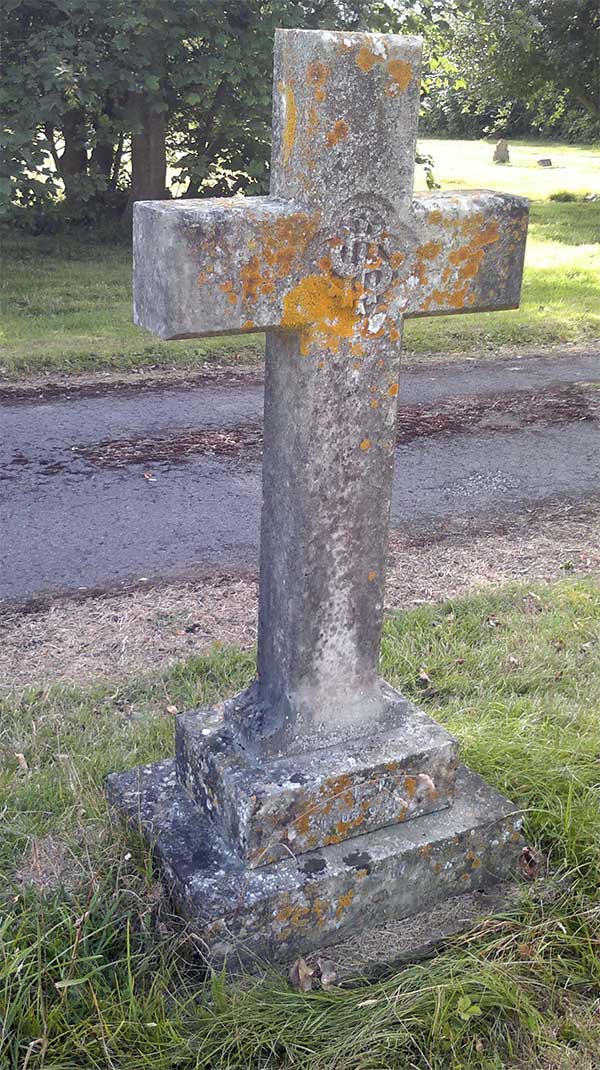 Doctor
James Loftus Marsden, an exponent and practitioner of Homeopathy and the
Water Cure, died at Elmswood, Ashburnham Road, Hastings on 6th February 1891
and was buried in
Hastings
Cemetery on 12th February next to his daughter Rosa Sydney Marsden (ref
11). Doctor
James Loftus Marsden, an exponent and practitioner of Homeopathy and the
Water Cure, died at Elmswood, Ashburnham Road, Hastings on 6th February 1891
and was buried in
Hastings
Cemetery on 12th February next to his daughter Rosa Sydney Marsden (ref
11).
Sadly Rosa Sydney Marsden died at St Leonards in 1877
aged only 34 years from an overdose of medicine (ref 10).
In August 2015 the Friends of Hastings Cemetery very
kindly located their grave from the register of burials and sent a
photograph (see opposite). The location is numbered DE U17.
The inscriptions on the faces of the pedestal below the
cross are extremely difficult to read now, but appear to be:-
Rosa Sydney Marsden
Born October -- 1843
Died December 21st 1877
On a second face,
JLM
Jesus Only
On the third face there appears to be a religious
inscription.
It is thought that Dr Marsden's large properties in Great
Malvern - Hardwicke House and Elmsdale next door, remained in Marsden family
ownership and then that of his mistress and their daughter until about 1905.
Children
Dr Marsden had five daughters and a son by his first wife
Lucy, a daughter by his second wife Mary and a daughter by his mistress
Sabina. However, none of his children married and some died in sad
circumstances.
There is some suspicion about the deaths of two of the
young Marsden daughters, Lucy and Marian, in 1853 - the children's deaths
are explored in a book 'The Water Doctor's Daughters' by Australian author
Pauline Conolly who gave a very interesting talk to the Malvern Family
History Society. The book (ref 10) was published by Robert Hale in 2013 and
locally is available from The Malvern Book Co-op in St Ann's Road and Great
Malvern library. It is a good read and provides an excellent overview of the
development of the water cure in Great Malvern and the best account we have
found of the life of James Loftus Marsden MD.
Legacy
Between about 1850 and 1875 James Loftus Marsden had an
extensive hydrotherapy practice in Malvern and must have then been quite an
important man, but today he is largely forgotten, as sadly he had no grand
children. Memories of his time in Malvern seem to have been eclipsed by the
careers of Doctors James Wilson and James Manby Gully who have gone down in
history as the founders of the Victorian water cure in the town. Only two of
Marsden's buildings remain (Elmsdale in Abbey Road and Royds Lodge in
College Road) together with a little-read book - 'Notes on Homeopathy, a
faded illustration of his water cure establishment, and the memorial to his
first wife Lucy Francis and their daughter Lucy Harriet, who are buried in
the Priory churchyard.
Dr Leopold Stummes
Dr Leopold Juda Stummes was born in Austria around 1809
and came to Malvern about 1849 as an assistant to Dr James Wilson; his story
is told by the late Janet Grierson in her book 'Dr Wilson and his Malvern
Hydro' (ref 1).
The National Archives records that Leopold Stummes, from
Austria, became a Naturalized British Subject on 25th May 1850 (certificate
1124).
In 1851 he published 'The Union of Hydrotherapy with
Homeopathy'.
Leopold's entry on the British Medical Register dated
20th October 1859, simply records Juda Stummes, MD, Pavia 1842. We assume he
was of Jewish extraction and may have added the name Leopold in order to
promote his career.
We first found Leopold Stummes mentioned in an
advertisement in the Times, on Saturday Feb 1st, 1845:
HYDROTHERAPY - The Lakes, St Oswald's
This water-cure establishment, in the beautiful vale of
Grasmere, is now in full operation, under the superintendance of Leopold
Stummes MD, Member of the Medical Faculty and Society of Physicians of the
University of Vienna, Honorary Member of the Faculty of Medicine of Pavia
and Naples, and late Physician to the Right Hon the Earl of Lichfield,
during his Lordship's long stay at Graefenberg, where Dr Stummes studied the
water cure for a year and a half, under Priessnitz, and from where he has
just arrived, and may be consulted at the establishment every day. For a
prospectus apply to L Stummes, MD, St Oswald's, Grasmere, near Ambleside,
Westmorland.
This business venture was probably not a success, as a
guide book relates that there was a cluster of lodging-houses, called St.
Oswald's, where a Hydropathic Establishment struggled on for a time but
found the Westmorland winters too long for invalids!
A Post Office Directory records Leopold in Malvern by
1849 but gives no address. The 1851 census records him staying at a hotel in
Cheltenham, whilst in 1861 he was a lodger at Abbey Villa and a neighbour of
water cure Doctor James Loftus Marsden, who was then living at North
Abbotsfield in Abbey Road.
We did not find Leopold in the England and Wales census
of 1871 and he next appears in the 1881 census living at the Imperial
Boarding Establishment in Croft Road, Torquay, where, probably retired, he
was recorded as a physician, born Hungary about 1811. Richard Metcalfe
suggests he might earlier have had a medical practice at Ash Hill House,
Torquay (ref 11); though we have found no evidence of this.
Leopold did not marry and his death the next year was
briefly reported in the Times, on Wednesday Sep 13th 1882 thus:
On 4th Inst at Craiglands, Ilkley, Yorkshire, Dr Leopold
Stummes, aged 73 years, formerly of Malvern.
Possibly he was staying at the
Craiglands Hotel
at the time of his death.
Leopold Stummes is perhaps best known to historians for
helping to found Malvern College. In 1862 he had acquired 26 acres of land
from the
Mason Estate, which he offered
for the college. The Times, Monday, May 25th, 1863 reported that building
works had commenced:
MALVERN PROPRIETARY COLLEGE
President and Visitor - The Lord Bishop of Worcester
Head Master - The Rev Arthur Faber MA, Fellow and Tutor
of New College, Oxford.
Arrangements have been made for commencing the College
Buildings so that they may be opened for the reception of pupils during the
summer of 1864.
For prospectuses and shares apply to the Hon Secretary,
from whom any further information can be obtained.
Leopold Stummes MD, Malvern, Hon Sec
Malvern College first opened during the snow of January
1865 to two dozen boys and half a dozen masters, not many months after the
planned date.
Leopold also acquired a further parcel of land on which
he built his own water cure establishment which he named Priessnitz
House. Possibly he tired of this venture or had problems with the
water supply, as the property was advertised for sale in 1867,
coincidentally the year of Dr James Wilson's death, and Leopold moved on
soon after. The hydro then became a private residence renamed Radnor
House. The photo below shows the extended Radnor House at it is
now. (A sketch of the building as it was in 1860 can be found in ref 1.)
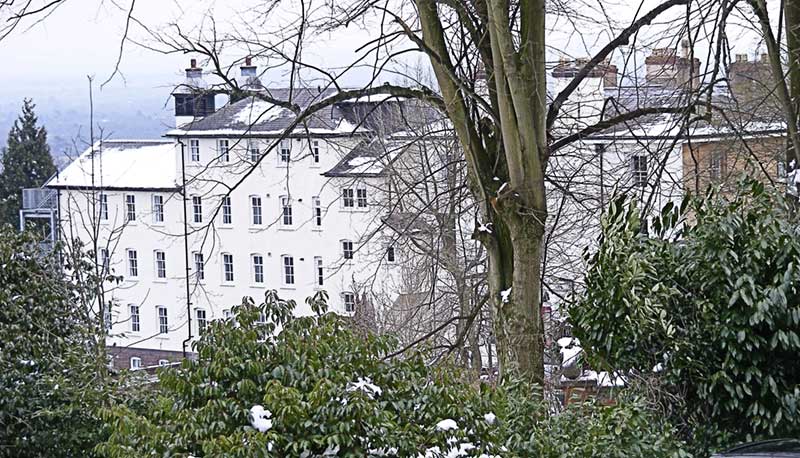
Radnor House
Between about 1867 and 1905 Radnor House was the home of
banker Christopher Dove Barker (1829-1905) and his wife Alice Gray Elmslie
(1835-1918) who had nine children. The building was then acquired by Malvern
College, extended and is now a boarding house. Alice was the cousin of the
architect, Edmund Elmslie, who
designed the Imperial Hotel opposite Great Malvern Railway Station, now a
girls' boarding school, Malvern St James.
Legacy
We know little about what Leopold Stummes MD did after
leaving Malvern but suggest that his chief legacy was in helping to form the
Malvern College Proprietary Company and the arrangement of its
financing.
Dr Edward Johnson
Dr Edward Johnson (1801 - 1867), moved from London, where
his children were born, and ran water cure establishments first at
Standstead Bury House in Hertfordshire (1843), then at Umberslade Hall near
Leamington Spa in Warwickshire (1846), before coming to Malvern in the
1850s.
The Stanstead Bury House hydro had been started in
1841 by Joseph Weiss, who moved on to manage the Sudbrook Park hydro near
Richmond; plagued by ill health he died abroad in 1847.
Edward Johnson had earlier published 'Domestic Practice
in Hydropathy' the purpose of which was to enable poor people to follow the
principles of hydropathy at home.
His first water cure establishment in Great Malvern was
at Ellerslie in Abbey Road (see photo below). He then moved across the road
to a large five story property named Malvernbury.
His son Walter took over the business following his
father's death in 1867, which was the same year Dr James Wilson died.
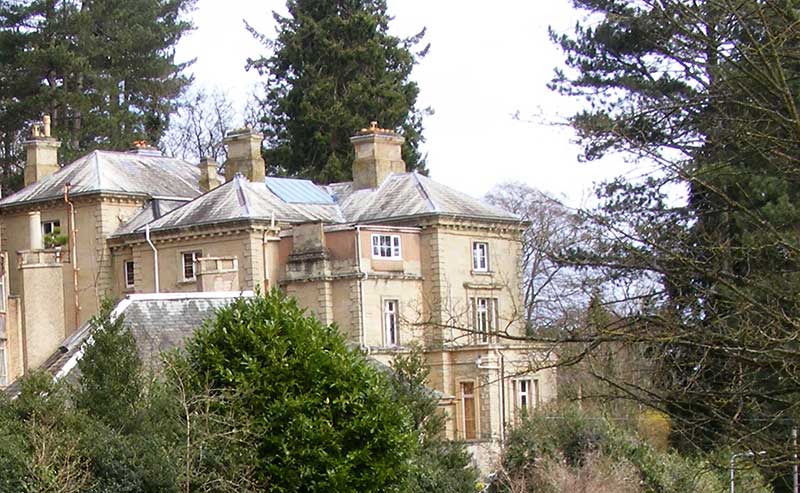
Ellerslie
In the foreground, behind the shrubbery, you can just
make out the roof of the lodge beside the entrance to Ellerslie on which
there is a green plaque.
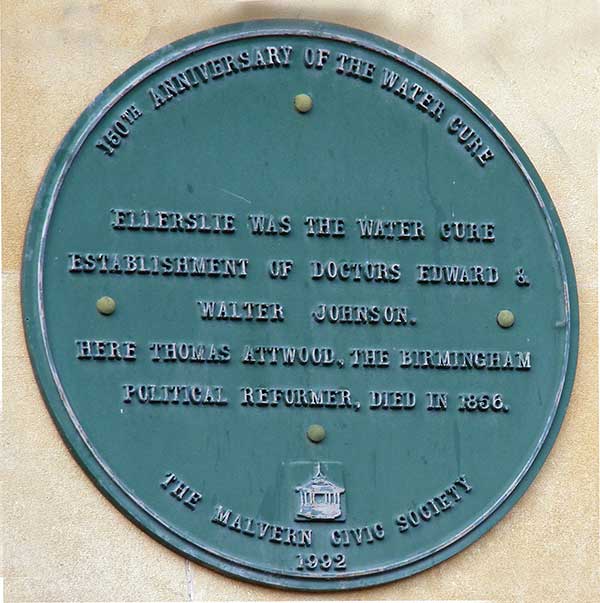 The
plaque
emplaced by Malvern Civic Society reads: The
plaque
emplaced by Malvern Civic Society reads:
Ellerslie was the water cure establishment of Doctors
Edward and Walter Johnson.
Here Thomas Attwood the Birmingham political reformer
died in 1856.
Thomas Attwood 1783 - 1856 was the first Member of Parliament for
Birmingham.
Despite Thomas Attwood being a frail old man, opponents
of the water cure attempted to discredit hydropathy, on account of his
death.
Ellerslie seems to have reverted to a private residence
after the water doctors left. In 1871, Albert Hudson Royds was living there,
after whom Royd's Lodge, of Malvern Freemasons, was named.
Circa 1900 James Atkins a retired manufacturer was living at Ellerslie;
previously he had lived at Hampton House in College Road. In 1911 widow
Julia Colt was living there.
In the twentieth century Ellerslie became a well
known school for girls, finally merging with Malvern College in 1992. In
2012 planning permission was granted by the MHDC for the site to be
developed as a retirement village and, after some delay, work began in 2015.
Dr Walter Johnson
Dr Walter Johnson married in 1867, South Tidworth
Hampshire, Mary Ann Sophia Young, the daughter of the Rector of Risley in
Bedfordshire by whom he had four children.
An advertisement in The Times on Aug 31st 1878 advised
the re-opening of Walter's water cure establishment, and a similar
advertisement on Saturday Nov 30th 1878 went on to say:
Hydropathic Establishment
Malvernbury, Great Malvern
Re-opened by Dr Walter Johnson. Patients and visitors now
received on winter terms.
The 1881 census records Walter and Mary living at 'Bury'
House in Abbey Road which was almost certainly Malvernbury, and an 1887
edition of the BMJ, listing doctors registered in Worcestershire, confirms
that Dr Walter Johnson was at Malvernbury.
When Mary died in 1888, Walter Johnson retired to
Kensington in London to live near his younger brother Horace Edward Johnson
MD.
Malvernbury was then acquired by Malvern College and used
as a boarding house until 1906.
The present Malvernbury, 61 Abbey Road, by A Hill Voysey,
1907, is a smaller property, set below Abbey Road between Hardwicke House
and the junction with College Road and is not the original five storey
building where Dr Edward Johnson and his son Walter practised.
In 1907, Malvernbury was rebuilt, possibly for solicitor,
William Dyson Perrins, grandson of the founder of the Worcestershire Sauce
business - in 1911 his wife Kate Perrins and son Meredith Dyson Perrins were
living there.
Malvernbury later became a nursing home and after that
closed the site was purchased by a development company, which we have been
told is named Crystalight Ltd.
The photo below shows Malvernbury after renovation in
March 2017, which is now divided into rented apartments.
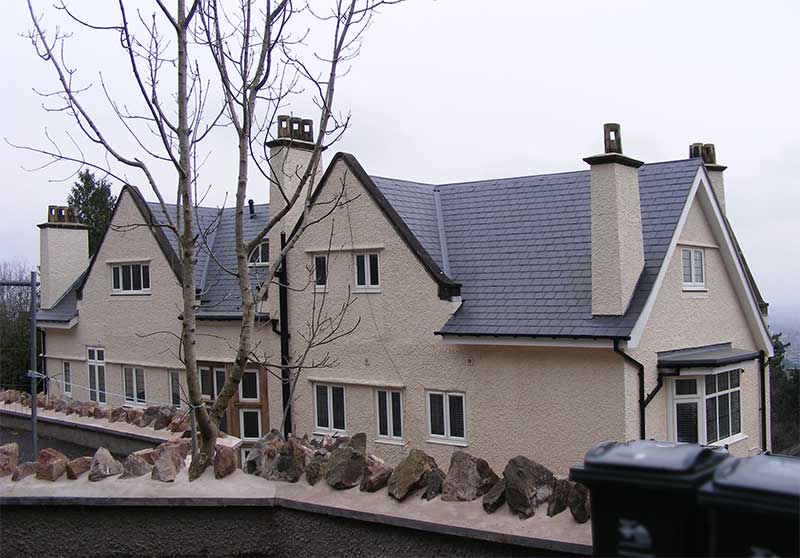
Malvernbury rebuilt 1907, and modernised, 2017
Steel uprights around a steep drop to the right of the
picture suggests further development on the site is planned. Malvernbury is
well situated on high ground above Malvern College.
Legacy
In his day Edward Johnson was probably one of the better
known water doctors, but now he seems largely forgotten. Perhaps he is most
remembered in the literature which records the visits of Florence
Nightingale to Malvern for rest and recuperation.
We are told that there was once a plaque on Malvernbury
recording that
Florence Nightingale had been a visitor at that spot between 1857 and
1860, but we have not seen it. Probably the plaque was removed during recent
modernisation of the property.
Dr Thomas Rayner
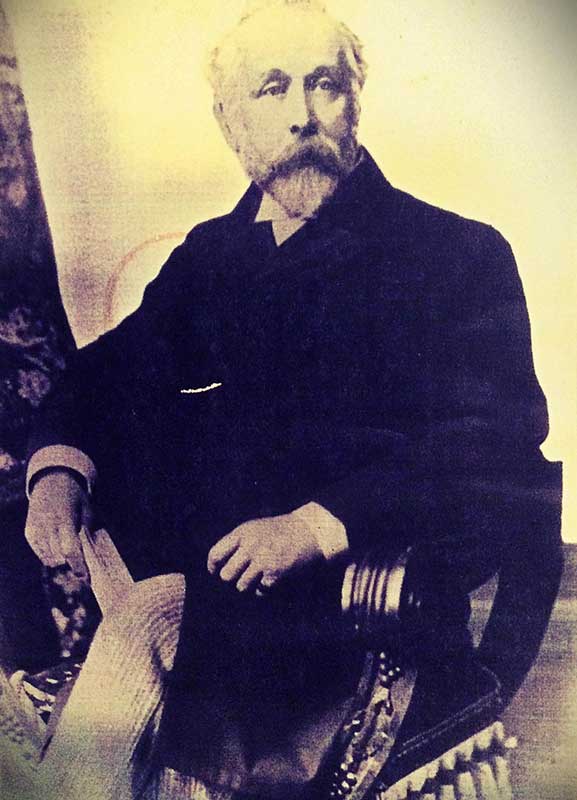 Dr
Thomas Rayner ran the Hydropathic 'Establishment' for 24 years following
the death of its founder James Wilson MD. See photo of Thomas opposite,
source: Rayner family Album. Dr
Thomas Rayner ran the Hydropathic 'Establishment' for 24 years following
the death of its founder James Wilson MD. See photo of Thomas opposite,
source: Rayner family Album.
Thomas was born at Bedworth, Nuneaton, Warwickshire about 1826, the eldest
child of schoolmaster John and Ann Rayner.
His father John died aged only 52 years on 14th September 1847 and the
Parish of Bedworth burial register records that John Rayner was for 22
years master of the National School.
His mother Ann then worked as a schoolmistress and finally as matron of an
almshouse before she too died at Bedworth in 1862.
Thomas is first recorded in Malvern in the 1851 census, in which he is
recorded as a Medical Assistant, lodging at the home of Frances Clewes, a
grocer's wife.
Thomas Rayner was admitted to the UK Medical Register on 1st January 1859;
MD Edinburgh 1858.
On 7th September 1859, at
St Mary Charlbury,
Thomas married Mary Sophia Franks, the daughter of a music teacher in the
registration district of Chipping Norton, Oxfordshire (ref 13).
A notice in the The London Gazette reported the bankruptcy of a Thomas
Rayner, and a further notice of 6th Dec 1861 (see below) indicated that he
soon hoped to be discharged from bankruptcy. However we think this may
relate to another medical man of the same name as Thomas trained in
Edinburgh while this man probably trained in Dublin:
Thomas Rayner, late of 14, Upper Temple Street, in the
city of Dublin in Ireland, and now of 11, Old Quebec Street, Portman Square,
in the county of Middlesex, Doctor of Medicine, having been adjudged
bankrupt under a petition for adjudication of Bankruptcy, filed in Her
Majesty's Court of Bankruptcy in London, on 16th day of November, 1861, a
public sitting, for the said bankrupt to pass his Last Examinations and make
application for his discharge will be held before Edward Holroyd Esq the
Commissioner for the said Court, on 24th day of January next, at the said
Court at Bassingball Street in the city of London at twelve of the clock at
noon precisely the day last aforesaid being the day limited for the said
bankrupt to surrender.
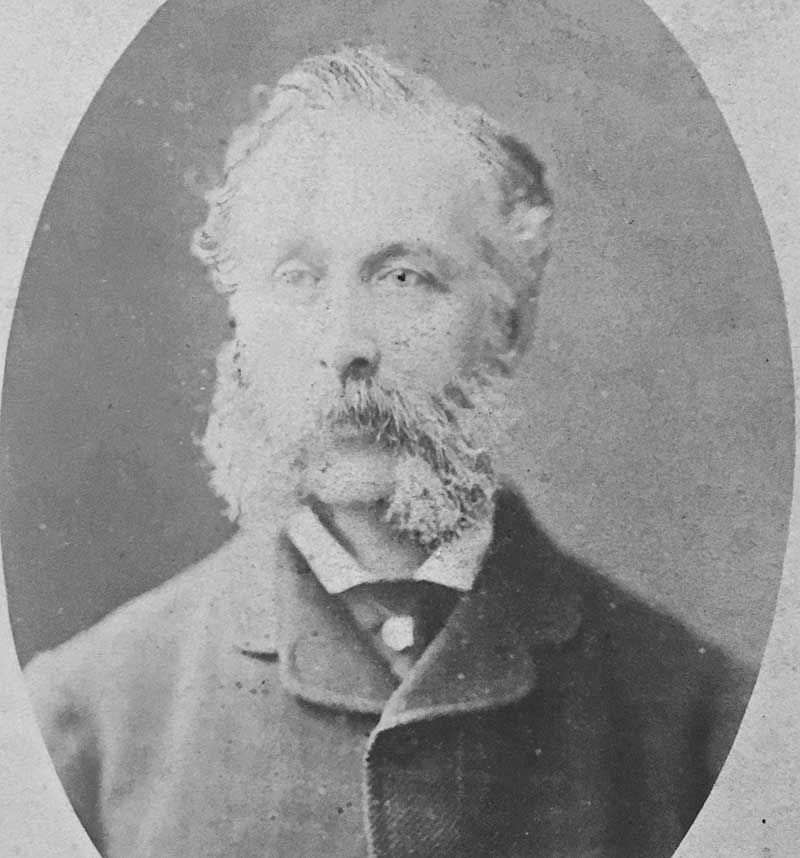
Thomas Rayner MD as a younger man, source Rayner family album
We did not find Thomas Rayner or his wife in the 1861 census, but his son
Herbert Henry Rayner was born in Malvern later that year. Thomas's
mother-in-law, widow Mary Franks, was also in Malvern in 1861, boarding at
Lansdowne Crescent in the home of physician James Williams.
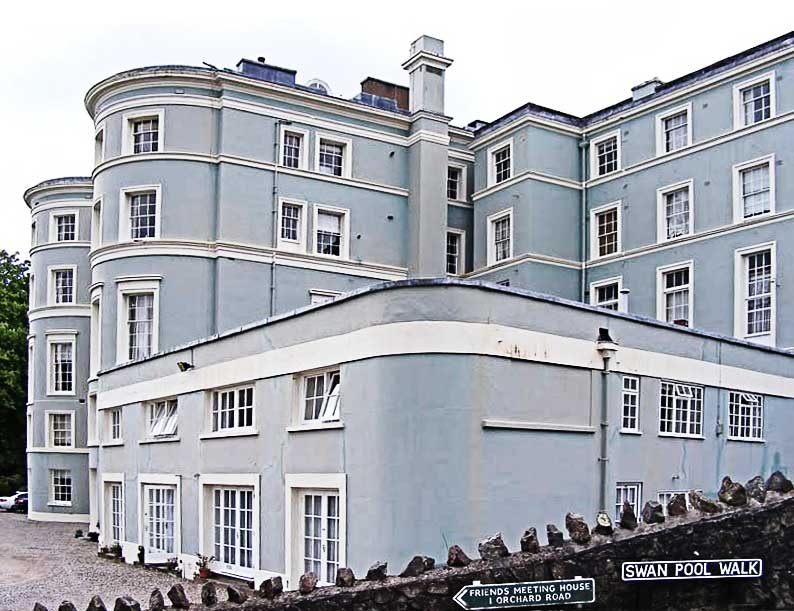 Thomas
is thought to have then worked on his own account at Clydesdale House in
Malvern Link, until about 1864 when he joined James Wilson MD at Park View
Hydro, taking over the 'Establishment' after Dr Wilson's death in 1867, in
partnership with James Wilson's son Henry Grattan Wilson MD. This
partnership was dissolved a year later on 29th September 1868, after which
the business was continued solely by Thomas (ref 4). Thomas
is thought to have then worked on his own account at Clydesdale House in
Malvern Link, until about 1864 when he joined James Wilson MD at Park View
Hydro, taking over the 'Establishment' after Dr Wilson's death in 1867, in
partnership with James Wilson's son Henry Grattan Wilson MD. This
partnership was dissolved a year later on 29th September 1868, after which
the business was continued solely by Thomas (ref 4).
In 1868 Thomas Rayner became a Freemason, joining Royds Lodge, as did James
Wilson's son Henry Grattan Wilson, and Rev James Fisk, vicar of Great
Malvern who had conducted the burial service for James Wilson.
The following advertisement appeared in The Times on Monday Jan 3rd 1870:
Hydropathy, Malvern, Dr Rayner's Establishment (formerly Dr Wilson's). The
dry, equable climate of Malvern renders it a most desirable residence for
invalids in winter; and in numerous cases the water treatment is even more
efficacious at this season than during the warmer weather. Prospectus on
application.
The 1871 census confirmed the head of the Hydropathic Establishment as Dr
Thomas Rayner, MD Edinburgh. He was still at the Hydropathic Establishment
in 1891 when he died.
Death
Thomas Rayner died on 6th October 1891 and a report of his death appeared in
the Malvern Advertiser on Saturday 10th October 1891 which read:
It is with unfeigned sorrow that we chronicle the death
of Dr Rayner, who for many years held the responsible and honourable
position of principal of the well known Hydropathic Establishment founded by
Dr Wilson, one of the early practitioners of the Hydropathic system.
Dr Rayner came to Malvern about 37 years ago, as an
assistant to Dr Gully, who at that time had a very extensive practice and
drew patients from all quarters. After being for some time in the service of
Dr Gully, the young man left Malvern for a season, but returned after no
long absence and commenced practice at Clydesdale House.
He subsequently joined Dr Wilson junior at what has long
borne the distinctive appellation of 'The Establishment', and on the
retirement of Dr Wilson, he took the entire charge of the same.
It is no derogation from the reputation of any other
Hydropathic establishment to say that the definite title which was assumed
was justified by the marked success which it achieved. From year's end to
year's end an unbroken chain of patients visited 'The Establishment', and
those that once came for treatment never failed to repeat their visit when
medical aid was again needed.
The duties of so large and important a place rendered Dr
Rayner a busy and crowded life and might well have excused his taking part
in public matters connected with the town. But Dr Rayner in 1888 sought and
secured a seat on the local board, mainly, we believe, with the object of
promoting a scheme for a better supply of water. He has lived just long
enough to see a Bill passed in furtherance of the project, but the work of
carrying out the scheme has fallen from his hands.
Till lately Dr Rayner had appeared to be in fairly good
health, but he has for some months suffered terribly, and it became evident
to those about him that something was seriously wrong. The symptoms
indicated the necessity of an operation, and this was performed last Sunday.
At first favourable results were anticipated, but they were not realised. On
Tuesday afternoon, at the age of 65 years, his spirit passed away to the
unchanging state - 'the undiscovered country from whose bourne no
traveller returns'.
Dr Rayner was deservedly respected and beloved by all
classes of his fellow townsmen, for his genial, gentle and pleasing bearing.
He was unshowy and unostentatious; but those who knew him know well his
charitable disposition and thoughtful generosity, while the remembrance of
his many deeds of kindness will cause his memory long to live in the
affectionate esteem of a large circle of friends.
The funeral took place this (Friday) morning.
The late Janet Grierson includes a brief account of
Thomas Rayner's life in her book about James Wilson and his Malvern Hydro
(ref 1) and suggests his death may have been caused by cancer of the bowel,
which was then a terrible disease as there was no effective treatment.
Burial
The burial register of Great Malvern cemetery records that:
Thomas Rayner, Doctor of Medicine, aged 65 years, of the
Establishment, Abbey Road, Malvern, was buried on the 9th October 1891 in
plot 1603. The burial service was conducted by Rev I Gregory Smith.
A
board in Great Malvern Priory records that Rev Isaac
Gregory Smith was vicar of Great Malvern between 1872 and 1896.
Thomas Rayner's memorial can be found, partly hidden by
long grass, on the right side of the path as you walk from the Wilton Road
entrance to the chapel.
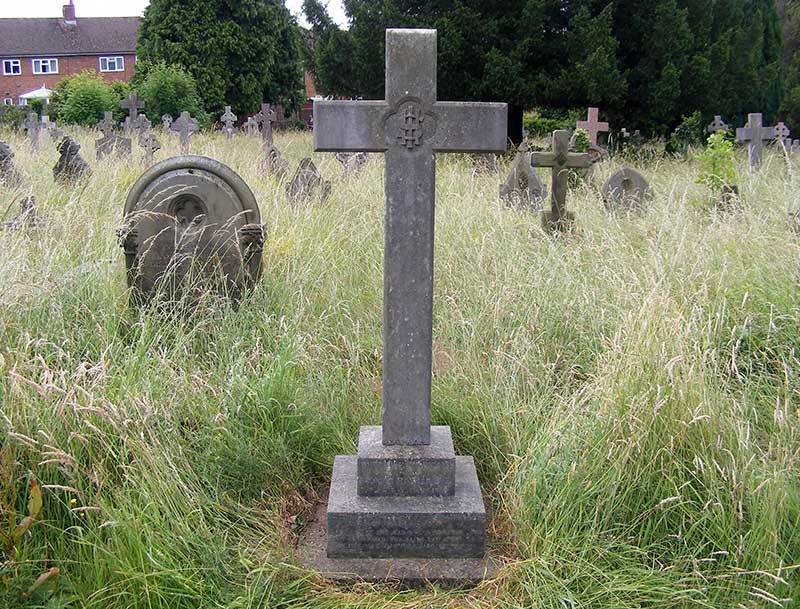
Memorial to Thomas Rayner MD
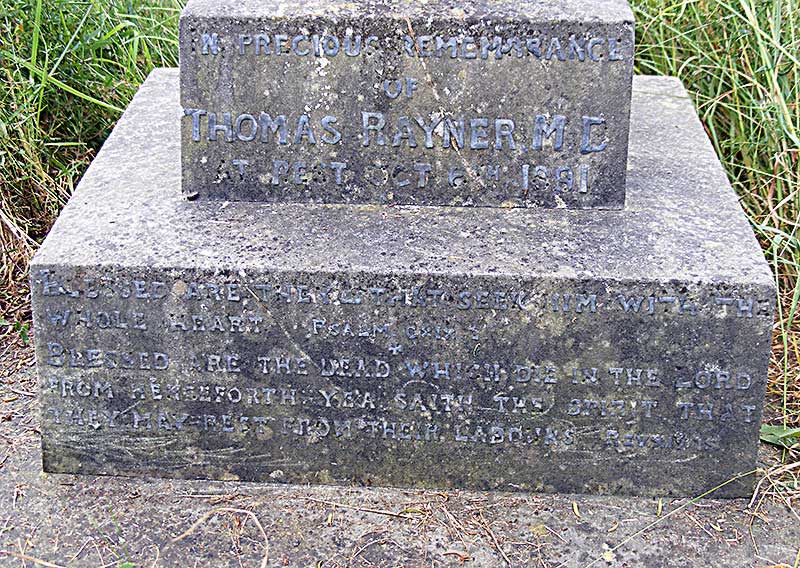 The
faded inscription on the pedestal reads: The
faded inscription on the pedestal reads:
In precious remembrance of
Thomas Rayner MD
At rest Oct 6th 1891
Blessed are they that seek him with the whole heart,
Psalm cxix
Blessed are the dead which die in the Lord, from
henceforth yea saith the spirit that they may rest from their labours, Rev 8
xi
Click photo of pedestal to enlarge inscription in memory
of Dr Thoma Rayner
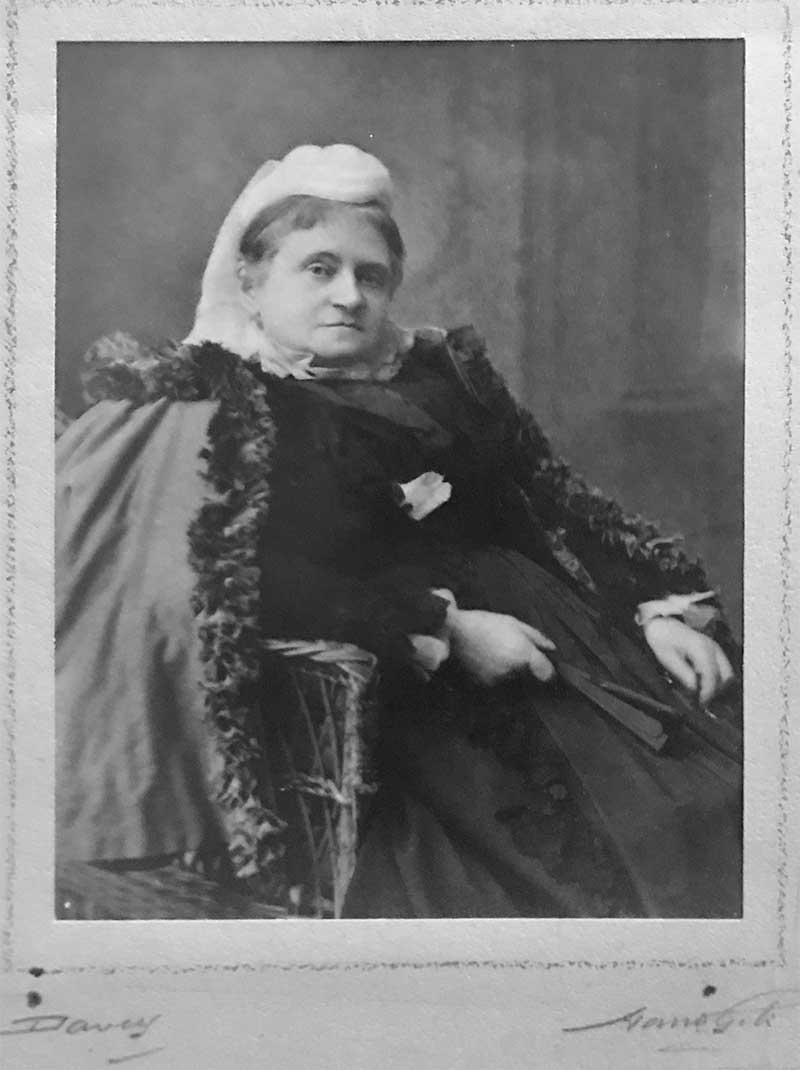
The bottom tier of the pedestal is now almost completely
sunk into the ground, but a further inscription can just be made out. It
reads:
Also Mary Sophia
Dearly beloved wife of the above
Laid into rest Oct 15th 1909
(See photo left: source Rayner family album).
Children
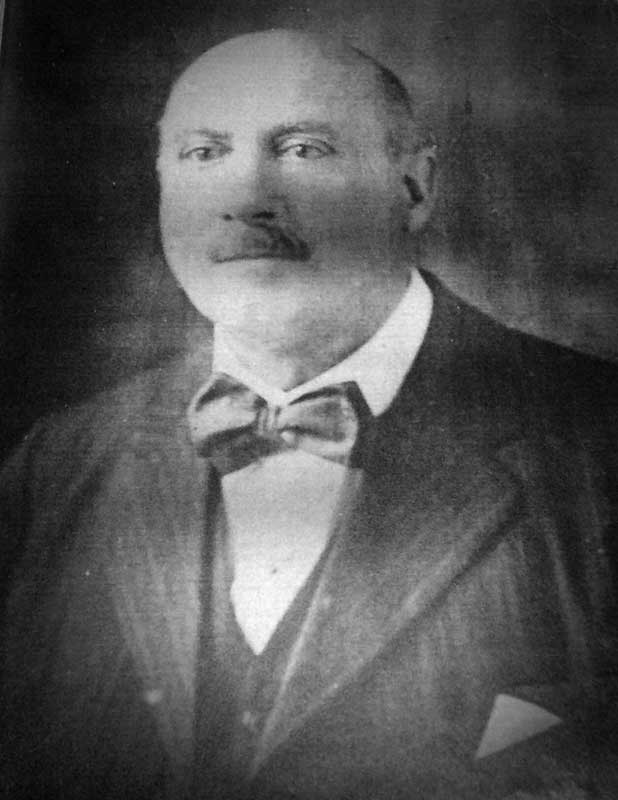 We
are very fortunate that a descendant of Thomas Rayner has been able to tell
us more about the family (ref 14). We
are very fortunate that a descendant of Thomas Rayner has been able to tell
us more about the family (ref 14).
Herbert Henry Rayner (1861 - 1930), see photo opposite, did
not aspire to become a barrister, or a doctor like his father, and he
emigrated from England to farm in the USA, later moving to New Orleans where
he loved the Parisian atmosphere and married Alice.
In 1881 Herbert Henry Rayner had been a student at Caius College, Cambridge.
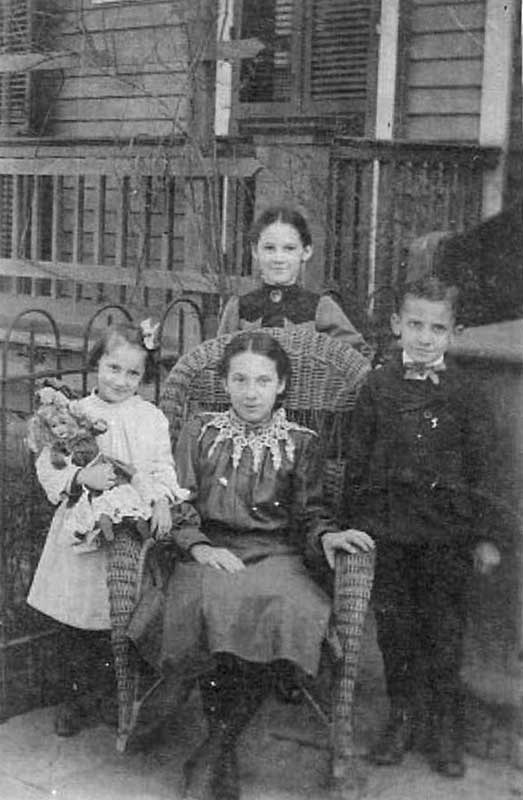 The
couple had a son and three daughters, see photo opposite taken in front of
their home in Canal Street, New Orleans before the Great War. The
couple had a son and three daughters, see photo opposite taken in front of
their home in Canal Street, New Orleans before the Great War.
In the photo are Marie to left, Adele in the chair, Clarisse behind the
chair and Sydney.
In later life
Sydney
Rayner, grandson of Thomas Rayner MD, became a famous opera singer,
possibly inheriting the musical talent of his grandmother's family.
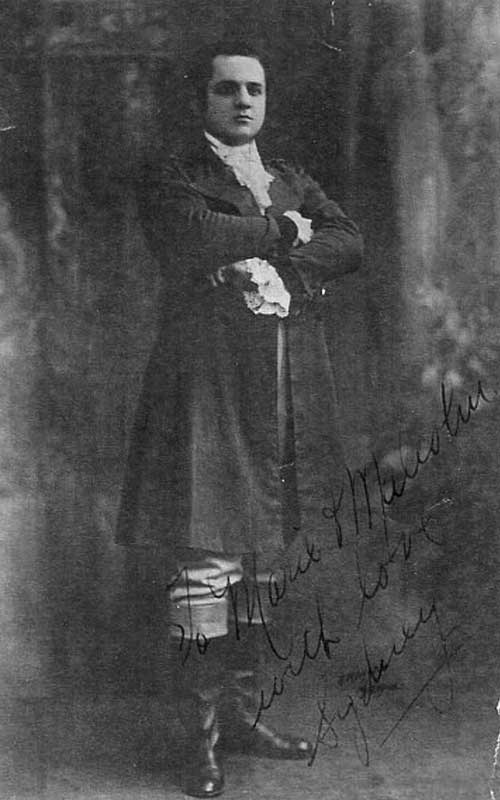
He sent the photo opposite to his married sister Marie
Sherfy and her husband Malcolm.
In addition to his son Herbert and grandchildren in the
USA, Thomas Rayner had three daughters and grandchildren in the UK.
The 1891 census records widow Constance Ann,
the eldest sister, at the Hydro in Great Malvern with a son, Edmund Haydn,
born Smyrna, Asia Minor, Turkey about 1886. We don't know what became of
Edmund Haydn, but possibly he died in Derbyshire aged only 16 years. Nor do
we know who Constance's husband was, but we wondered if he could have been
Edmund Haydn, the son of a Professor of Music, who lived in Smyrna. Do let
us know if you can tell us more about him.
The photos below may be of Constance and possibly one of
her husbands since the photos were taken by the same photographer; however
another possibility is this could be Constance's sister
Beatrice and her husband surgeon Charles
John Paterson (source: Rayner family album, ref 22).
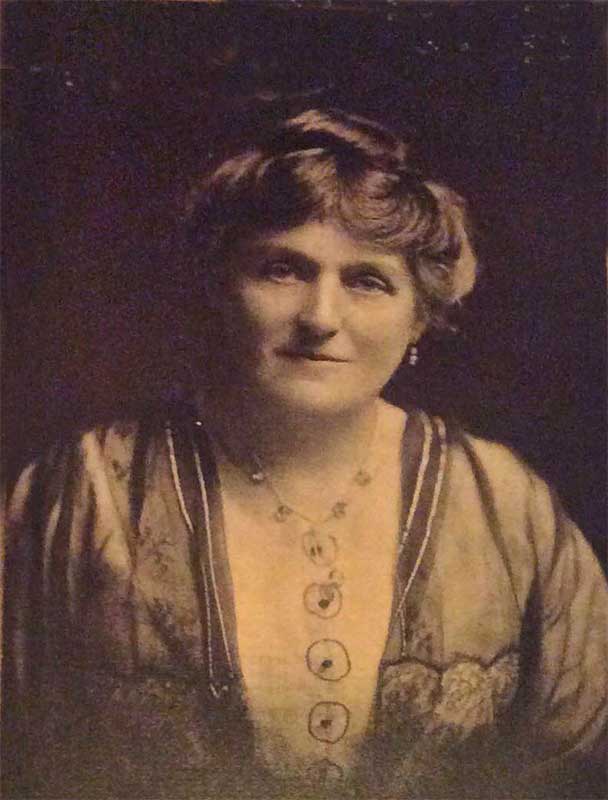 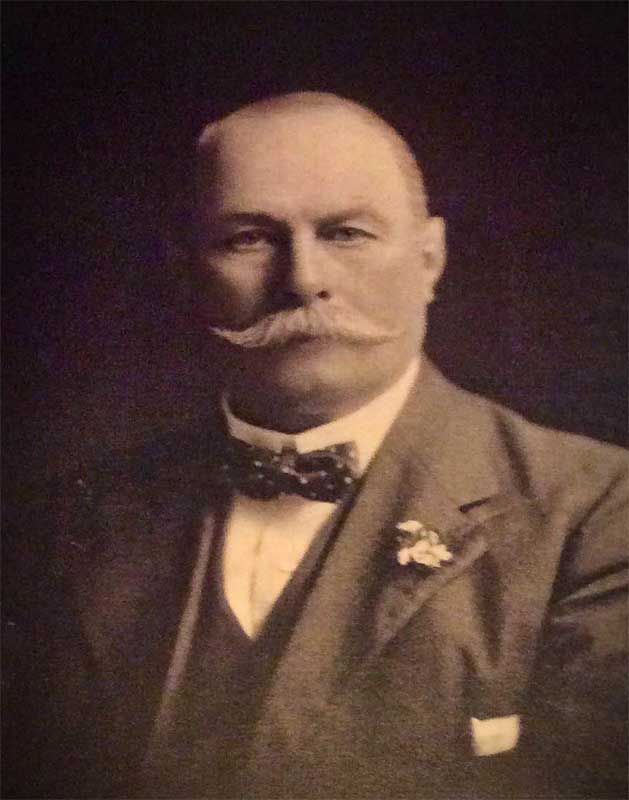
In 1893, two years after her father's death, at Portsea
Island, Constance married, second, Edward Cecil Rich, the son of banker
Joseph Rich.
Edward was born in Scotland in 1857, and baptized in
London. His parents had married in India, where his elder brother Joseph was
born. The 1871 census records Joseph and Edward boarding at
Cranbrook
Grammar School in Kent. In 1891 aged 34 Edward became a Freemason
joining Berar Lodge in Bombay, where he is described as an 'Agent' of
Shegoan, where cotton was traded.
Constance and Edward do not appear in the 1900 and 1911
England and Wales census and so were most likely living abroad; a 1929
passenger list records them returning to England from Indonesia.
Edward died at London in 1931 and Constance at East
Molesey in Surrey in 1949. Constance's executor was her nephew, land agent
Kenneth Leslie Paterson, the son of her sister Beatrice.
Aimee Gertrude Rayner, the youngest
sister, did not marry and she died at Bella Vista, Croyde Bay in Devon in
1926. In some records she is recorded as Annie.
Beatrice Mary Rayner
was born in Malvern in 1865. On 8th September 1887 at Great Malvern Priory
she married surgeon Charles John Paterson (1862 - 1926). He was the son of
John Borthwick Paterson, whose family owned chromium mines in Turkey. The
vicar of Great Malvern, Rev Isaac Gregory Smith, assisted at the ceremony.
John Borthwick Paterson died two years after his
son's marriage at Bournabat, near Smyrna on 7th November 1889; he was aged
71 years. His wife Preciosa Henrietta Paterson died at Smyrna on 11th May
1893; they had also lived at Elmstone Hall in Kent.
Beatrice and Charles had four children, one of whom
married a solicitor, one of whom became a marine engineer, one served in the
merchant navy, and one became a land agent.
Beatrice died in Derbyshire in 1936 and is buried in
Great Malvern cemetery on the opposite side of the path
to her parents. Thankfully all her sons survived the Great War.
Siblings
Thomas Rayner had 4 siblings; sisters Ellen, Ada and
Emma, and a brother John, of whom there appear to be no living descendants.
Ellen, born in 1829, became a governess;
we have been unable to trace what happened to her after 1861 when she was
working at a school in Fulham.
Ada (1831 - 1902) married in 1876 at
Great Malvern Priory, photographer Frederick James Loft, the son of
clergyman John Loft. They had no children.
Emma (1833 - 1912) had earlier married,
in 1866 at Bedworth, baker and grocer Robert Moor Brewin. They had no
children.
John (1835 - 1903) became a medical man
like his elder brother Thomas, married, and had a daughter Susanne Caroline
Rayner. He appears to have retired early moving to Exmouth in Devon.
Following his death his widow and daughter moved to Great Malvern.
The National Probate Calendar records that John's widow Susannah Rayner of
Chatsworth Great Malvern died at Fairholme Nursing Home on
13th March 1927; Fairholme is now the house named Clanmere in Graham Road.
The couple's daughter Susanne did not marry and latterly lived at Marston in
Albert Park Road Great Malvern - she died at Birmingham in
1955.
The UK Medical Directories 1885, 1895 and 1900 together
record:
Rayner John, Malvern Cottage, Exmouth Devon (retired) -
LRCP Edin 1869; LRCS Edin 1860; LSA 1860; (Qu. Coll. Birm, Glasg and Edin);
House Surg. Chorlton Disp 1862 - 1867; Asst. Surg. 1st Warick Militia and
late surg. Warwick Prov. Disp. Author of 'Food, Digestion and Diet; with the
Domestic Treatment of Indigestion, Biliousness, Constipation & c.'
It would seem John Rayner MD had named his final home
after the town where his elder brother Thomas Raynor MD had been the manager
of one of the best Hydropathic establishments in England.
Legacy
Thomas Rayner MD successfully continued to run the
Malvern Hydro for 24 years after the death of its founder James Wilson MD
and actively participated in town affairs. He published books about treating
skin conditions, and many patients would have benefited from visiting his
establishment. Perhaps though, he would have considered his lasting legacy
to be his grandchildren in England and the USA.
Dr John Campbell Fergusson
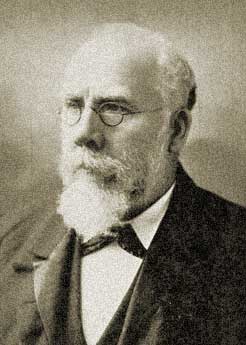 Dr
John Campbell Fergusson leased the 'Establishment' when Dr Rayner died, and
he and his family were still at the Hydro in 1911. Dr Fergusson first
appears in Kelly's Worcestershire Trade Directory of 1892. Dr
John Campbell Fergusson leased the 'Establishment' when Dr Rayner died, and
he and his family were still at the Hydro in 1911. Dr Fergusson first
appears in Kelly's Worcestershire Trade Directory of 1892.
'Hydropathic Establishments'
Fergusson John Campbell, LRCP, LRCS Edinburgh, Abbey
Road, Great Malvern
Some researchers have wondered if he had the medical
qualifications he claimed, but he and his eldest son are both listed in the
UK Medical Register of 1911.

A lengthy report in the Times indicates there was a
serious outbreak of Typhoid in 1905. Dr Rayner attempted to sue the Malvern
UDC for supplying contaminated water, but it appears a contributory factor
was a broken sewer. The resultant scandal, legal fees, claims and loss of
business must have cost him of the order of £1M in today's money. You will
find a more detailed account in ref 18.
In 1909 Dr Fergusson and his eldest son Dr John Newberry
Fraser Fergusson, who were then running the business, were declared
bankrupt; and on 21st February, 1920 Dr Fergusson senior of the Hydro, Great
Malvern, died.
It seems the family had been able to refinance the
business and Malvern Hydro Ltd was formed in 1915. Kelly's records that in
1924 Dr Fergusson's youngest son, Captain Louis Roy Fergusson, a survivor of
the Great War, was a director of Malvern Hydro Ltd, Abbey Road.
By 1930 the end of the road had been reached, and Park
View, as we know it now, became the County Hotel, Great Malvern, one of a
chain of hotels owned by hotel entrepreneur Lady Constance Mary Honywood
(1880 - 1956), daughter of a clergyman, who had the advantage of a very rich
husband, Sir Courtenay John Honywood (1880 - 1944), 9th Baronet of Kirby
Hall Essex.
Family
The origins of Dr John Campbell Fergusson are somewhat
obscure, but we received an enquiry (ref 15) in September 2016 from a
descendant of his brother, which read:
I am researching my family history, here in Australia,
for my paternal grandmother's family (Fergusson). We have in our possession
a book titled 'Scotland for Ever' which was produced to raise funds for the
Red Cross during World War 1. On the inside cover of this book are two
labels, obviously the original packing labels. The first is the address
label to my great grandfather, David Mitchell Fergusson Jnr. The label is
printed with The Hydropathic Establishment, Great Malvern.
The second label would probably be classed as a custom's label, today - the
person making the declaration, is JC Fergusson MD, The Hydro, Great Malvern.
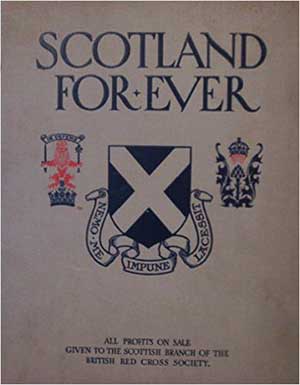 Scotland
for Ever (see cover opposite) was a gift-book of the Scottish regiments,
published about 1915 by Hodder and Stoughton, for the Glasgow Herald
newspaper. Scotland
for Ever (see cover opposite) was a gift-book of the Scottish regiments,
published about 1915 by Hodder and Stoughton, for the Glasgow Herald
newspaper.
Dr Fergusson's brother, David Mitchell Fergusson senior
(1828 - 1910), had emigrated from Scotland to Australia about 1853
where he married Mary Waddell. Since he was dead the recipient of the book
would have been his son of the same name.
In 1858 a newspaper reported that David Mitchell senior
was a storekeeper in Ballarat, in some financial difficulty.
The
Age, Melbourne had earlier reported on Thursday 10th December 1857:
David Mitchell Ferguson of Beechworth, now a prisoner in
Her Majesty's jail, storekeeper. Liabilities, £351. 5s. 1d; assets £323.
18s. 5d. Deficiency, £27. 6s. Official assignee Mr Laing.
It is hard to imagine someone being imprisoned for such a
small debt nowadays when debts of tens of thousands of pounds can be racked
up on a credit card!
David Mitchell Fergusson was one of the earliest
Victorian colonists, and Ballarat was then a gold rush town. It must have
been a challenging and exciting time.
In1886 the
Australasian newspaper reported that his son, blacksmith David Mitchell
Fergusson junior, also had some financial difficulties. He had earlier been
lessee of the
Williamstown Steam Ferry.
A family notice in 'The
Australian' newspaper, Saturday 26th November 1910, reported the death
of Dr John Campbell Fergusson's elder brother David (ref 16):
FERGUSSON:- On the 17th November, at his son's
residence, 'Bonatta', John-street, Mordialloc, David Mitchell Fergusson
senior, late of Beechworth, brother of Dr J C Fergusson, Malvern, England,
aged 82, Colonist of 57 years.
The Fergusson's parents were schoolteacher Peter
Fergusson and Margaret Mitchell (ref 17). We have not found the family in
the 1841 - 1871 census but a record in the 1851 Scotland census might refer
to them. The record refers to Donald M, rather than David, but otherwise
reflects the brothers dates and places of birth; the records suggests that
their mother, possibly a widow, was then a dress maker in Glasgow, David
born Lochgilphead, Argyll about 1828 was a provisions dealer, and John, born
Tarbet, Argyll about 1835, was a provision apprentice.
John Campbell Fergusson does not appear in the census
again until 1881 when he was an Estate Manager living with
a wife at Sutherland Villa, Wick, Caithness. He had married at Ferry Hill,
Aberdeen in 1880, Christina Mackie youngest daughter of newspaper editor
John Mackie who in 1851 had been a publisher employing 7 men and 4 boys.
John disappears briefly in 1891, when his wife is
recorded in Glasgow with their three sons and her widowed sister Sophia
Katherine Smith, and her son John Mackie Coates Smith who became a surveyor.
In 1901 and 1911 the Fergussons are at the Hydro in Great Malvern.
So where was John Campbell Fergusson between 1851 and
1880; did he sail to Australia with his brother and spend some time there?
Another mystery is how having been an Estate Manager in
the far north of Scotland, did he come to qualify as a doctor and afford to
become manager of the Malvern Hydro?
This question is partly answered by a clue in the 1895
edition of the UK Medical Register which gives Dr Fergusson's last known
address as Forres, Edgehill. That name is familiar to us, for a great uncle
had been manager of the Cluny Hill Hydro
at Forres on the Moray Firth and it seems quite likely that Dr John Campbell
Fergusson had either worked there or certainly visited the establishment.
Possibly also, as a registered doctor, he was able to get a loan from the
bank, and obtain support from his father in law.
The 1891 Scotland census records that the manager of
the Cluny Hydro at that time was Richard Bond born Dumfries about 1855;
amongst others, also in residence were James Love Doctor of Medicine
(retired), born Ireland about 1845, and William L Laurie Physician (retired)
born Dumfries about 1817.
Children
Dr John Campbell Fergusson and Christina Mackie had
three sons, John Newbery Fraser, Argyll, and Louis Roy, who were educated at
Malvern College. John and Argyll went on to St John's College, Cambridge.
John Newbery Fraser MRCS, LRCP, FRCS Edin, became a
Physician and during WWI served as a Captain with the Royal Army Medical
Corps, in France. His son
John Douglas Fergusson, born 5th December 1909 in Great Malvern, became
a respected surgeon specialising in urology.
Argyll Fergusson joined the army reaching the rank of
Major in the Middlesex Regiment. Wounded during WWI he became a fruit farmer
in Battle Sussex.
Louis Roy Fergusson came back to Malvern after serving
as a Captain with the Royal Field Artillery, and became a director of the
Malvern Hydro. We think he may have earlier worked at Rossall School. He
latterly lived at Harrow and we wondered if he became a schoolmaster?
More about the history of 'Park View' can be found in an
excellent booklet published by Roger Hall-Jones (ref 2); a copy of which is
held in Malvern Library.
The photo below, taken from Grange Road, shows the rear
of Park View as it is now. You can buy an apartment and live there if you
want to!
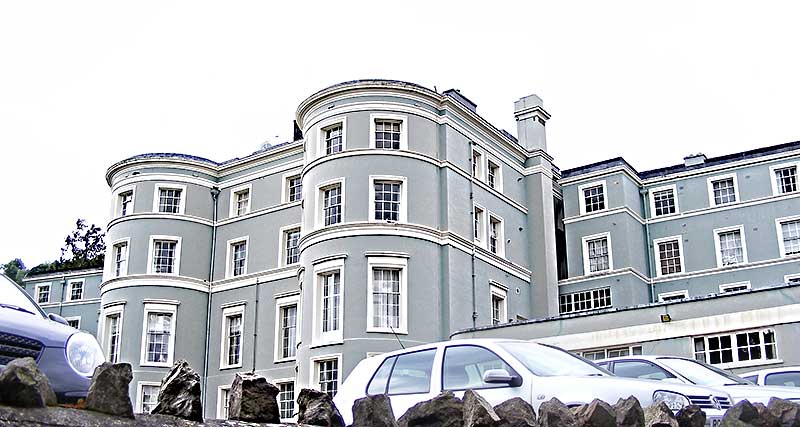
Postscript
Cluny Hill Hydro
By chance we found a great uncle, William Brown, had also
been involved with the last days of the water cure in Great Britain. In 1911
he was manager of the Victoria Hotel at
Woodhall Spa in Lincolnshire. After serving as a recruitment officer for
the Royal Scots Fusiliers during the Great War he became manager of the
Hydropathic Establishment at
Cluny Hill, Forres, Morayshire in Scotland. Sadly he died of
tuberculosis at Forres Hospital in 1923 aged only 49 years. Possibly he had
followed in the footsteps of Dr John Campbell Ferguson who had been in
Forres circa 1891.
The Cluny Hill Hydro had opened in 1864. The first
resident physician was Alexander Munro, who earlier had started a small
hydro at Lochhead near Aberdeen. Another website relates:
In 1851 the Reverend Alexander Munro bought the mansion
and grounds at Lochhead, about a mile to the north-east of Aberdeen, and
opened a hydropathic establishment there. At the same time, he was also
Congregational minister of the small chapel at Skene, some six miles away.
He was widely known as Dr Munro though his qualification came, in fact, from
a hydropathic college in the United States. Although previously he had
successfully completed the required course for medical students at the
University of Aberdeen, he was not allowed to graduate as he was already
practising as a hydropathist.
Lochhead started in a small way with fairly primitive
facilities. Showers were taken in a small hut near the house and the
stronger patients were expected to pump the water from a stream nearby to a
tank on the roof'. But the facilities were gradually improved and in 1857
Munro sold the establishment to a new partner, Dr William Meikle, while
continuing to conduct its daily running as superintendent.
Andrew Munro then became resident physician at the Cluny
Hill Hydro. Aged 70 years, was still at the hydro in 1881, but died in Devon
two years later.
Managing these hydropathic establishments must have been
a difficult business. You might find the regulations of the Cluny Hills
Hydro interesting; they remind me of being at school!
Extract from Cluny Hills Hydropathic Company terms
REGULATIONS. Breakfast at half-past eight o'clock. Dinner
at half-past one, and tea at half-past six. On Sabbath, Dinner at a quarter
past one, Tea at five o'clock.
The bell is rung a quarter of an hour before each meal,
and the gong at the time for commencing.
Parties take their places at table in the order of their
arrival at the establishment, commencing at the lower end.
Punctuality in coming to meals is expected. No meals can
be served in private rooms within half-an-hour before, or half-an-hour after
the public meal.
Worship immediately after Breakfast, and in the evening
at Nine o'clock.
Gas turned off in public rooms at ten o'clock, and from
bed-rooms at eleven o'clock, p.m. Patients and visitors are requested to
turn off the gas in their rooms immediately after they have done using it,
and to be careful to see that it is quite turned off before going to bed.
As disturbance when falling asleep is so hurtful to
delicate patients - involving the loss of sound sleep for half the night -
it is indispensable that perfect quiet be maintained in all parts of the
house after a quarter past ten o'clock at night.
All talking in lobbies, staircase landings, and rapping
of doors, are strictly prohibited.
Those requiring evening treatment should retire to their
bedrooms at nine.
Patients are requested to be prepared for their baths at
the hours mentioned by the bath attendants, who take them in the order of
their arrival.
The bath attendants having to rise early, no service must
be expected from them after half-past nine p.m.
Visitors are expected to conform to the rules of the
House, and are not allowed to bring to table anything forbidden to patients.
No Smoking allowed in any part of the establishment.
Excursions and picnic parties to places of interest in
the neighbourhood are encouraged. For obvious reasons it is expected that on
all such occasions strict economy will be observed in the arrangements. It
is specially requested that no wines or spirituous liquors be introduced.
Those wishing their rooms kept for them during a week's
absence, will be charged one guinea; if absent only a few days, no deduction
will be made from the usual weekly charges.
Consultation on Monday, Tuesday, Thursday, and Friday,
from ten to half-past eleven a.m. Patients admitted in the order of their
arrival at the Establishment. Special Consultations at any other hour, by
arrangement, as patients may find it necessary.
As the hours devoted to consultation are strictly
business hours, and as a delay of minutes is a serious hardship to those who
are waiting for admission, it is understood that no general conversation can
be entered upon in the consulting room, and that the patient is expected to
retire as soon as the Doctor has handed the prescription, and ceased asking
questions.
Accounts rendered on Wednesday. Attendance given in the
steward's room to receive payments from three to four o'clock. The day of
arrival is charged as a whole day; the day of departure is free.
Patients are recommended to bring with them a blanket,
three sheets, and two towels, for bathing purposes. When it is inconvenient
to do so, these articles can be had at the establishment for a small charge
per week.
References
- Grierson Janet, Dr Wilson and his Malvern Hydro, published by
Malvern Museum 1998.
- Harcup John Winsor, The Malvern Water Cure, printed by Aspect
Design, second issue 2010.
- Hall-Jones, Roger, The Story of Park View Malvern, 2nd edition 2012,
printed by First Paige.
- The London Gazette, Jan 12th 1869
- Jenkins Elizabeth, Dr Gully, published by Michael Joseph Ltd, 1972.
(A fictional account based on fact of the romance between Dr James Manby
Gully and Florence Ricardo.)
- Communication from M Losse, bloodlinesancestry.com, 16 Feb 2016
- Grierson Janet, Temperance, Therapy & Trilobytes, Dr Ralph Grindrod:
Victorian Pioneer, published by Cora Weaver, printed by Aldine Press,
ISBN 1 873809 42 5
- Renger F, Banks C, Hartley Woolley B, Lecture 'From Baldenhall to
Barnards Green', Malvern Museum, 1st April 2016
- The will of Captain James Marsden of Kempsey in Worcestershire,
dated 14th September 1836
- Conolly Pauline, The Water Doctor's Daughters, Robert Hale, 2013
- Communication from the Friends of Hastings Cemetery 2 Aug 2015
- Metcalfe Richard, The Rise and Progress of Hydropathy in England and
Scotland, 1912
- The London Gazette, Dec 6th 1861
- Communications from W Keeler, June and July 2016
- Communication from Lesley Argaet, September 2016
- The National Library of Australia, Trove, Digitised newspapers
- Scotlands People website
- Weaver, Cora and Osborne, Bruce, Aquae Malvernensis, The Springs and
Fountains of the Malvern Hills, printed by Aldine Press, 1994.
- England census 1851 to 1911.
- National Probate Calendar
- Hereford Journal, 29th June 1859
- Communications from W Keeler, October 2017
- Communication from Colin Fenn, August 2019
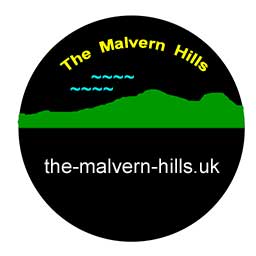
Back to top
If you are able to correct or add to the story on this
page please get in touch by contacting the webmaster
|

